


| 1. | EKTAXH S: EKTAXIS | "Battle Order" |
| 2. | DIASTHMA: DIASTIMA | "Interval" |
| 3. | TA DORATA EPI TON DEXION OMON ECEHN TA DORATA EPI TON DEXION OMON E-HIN | Raise shield/spear at rest on right shoulder |
| 4. | EPI DORU KLINAI: EPI DORY KLINAI | Turn to the spear,"RIGHT" |
| 5. | EP, ASPIDA KLINAI: EP' ASPIDA KLINAI | Turn to the shield, "LEFT" |
| 6. | META BOLH: META VOLI | "About turn / face" |
| 7. | TA DORATA EIS PROBOLIN KAQENTAS: TA DORATA E-IS PRO-VOLIN KATHENTAS | Lowering the spear's for the charge. |
| 8. | EFODOS: EF-ODOS / ????????: EPI-DROMI | "Advance" / " Charge." |
| 9. | PUKNOSHS: PYK-NO-SIS | "CloseOrder " |
| 10. | EPI DORU: EPI DORY | To the right/raise the spear! |
| 11. | SUN-ASPIDOW : SYN - ASPID-OO' | "Lock Shield's" |
| 12. | ANAKLHSIS : ANA-KLI-SIS | Retreat |
| 13. | AKINHTOS : AKI-NI-TOS | "Halt" |
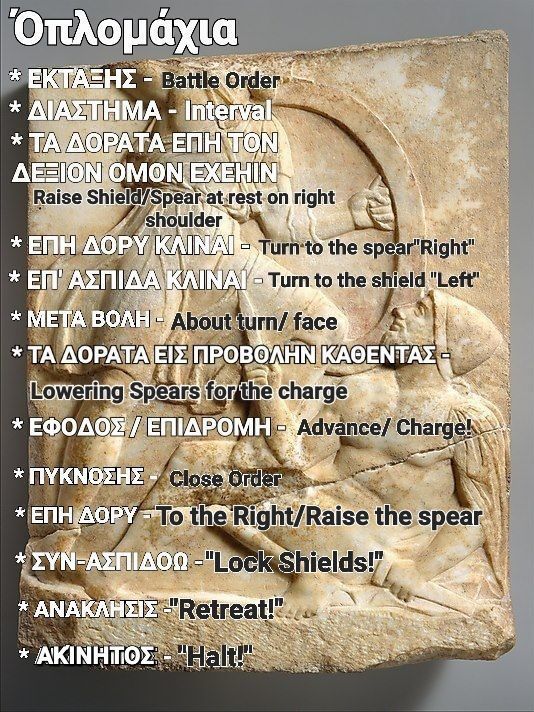
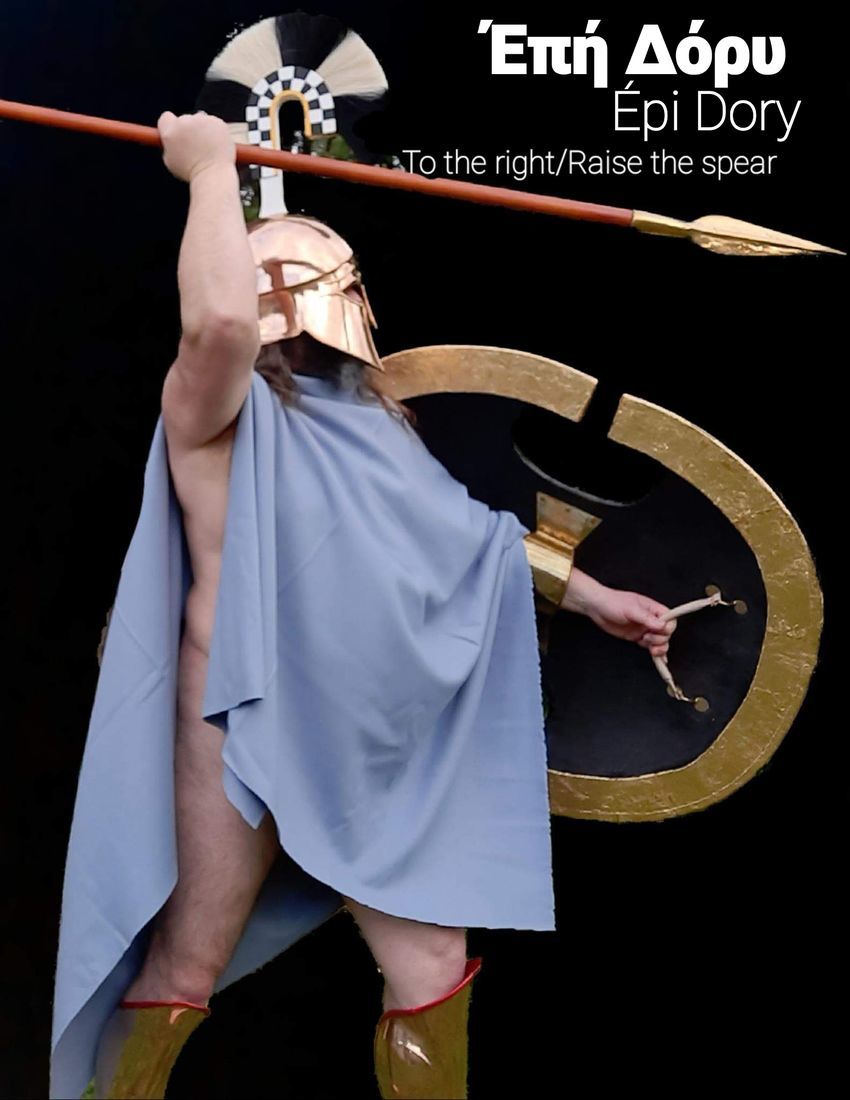
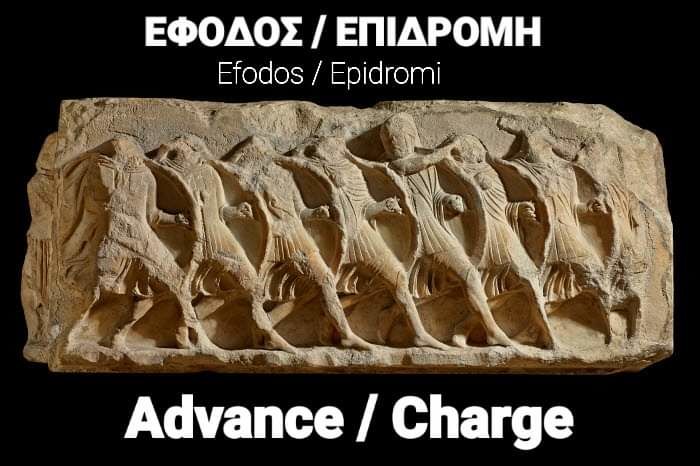
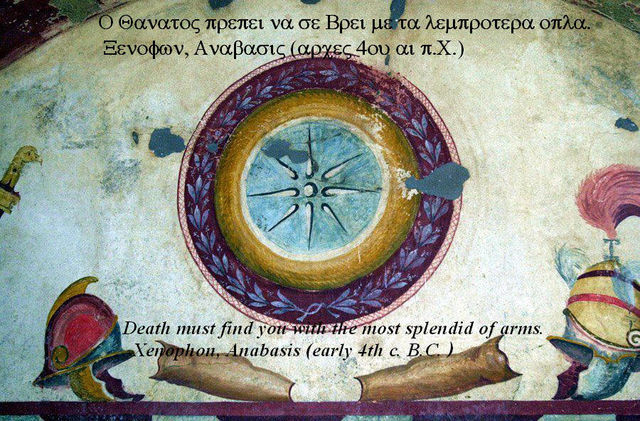
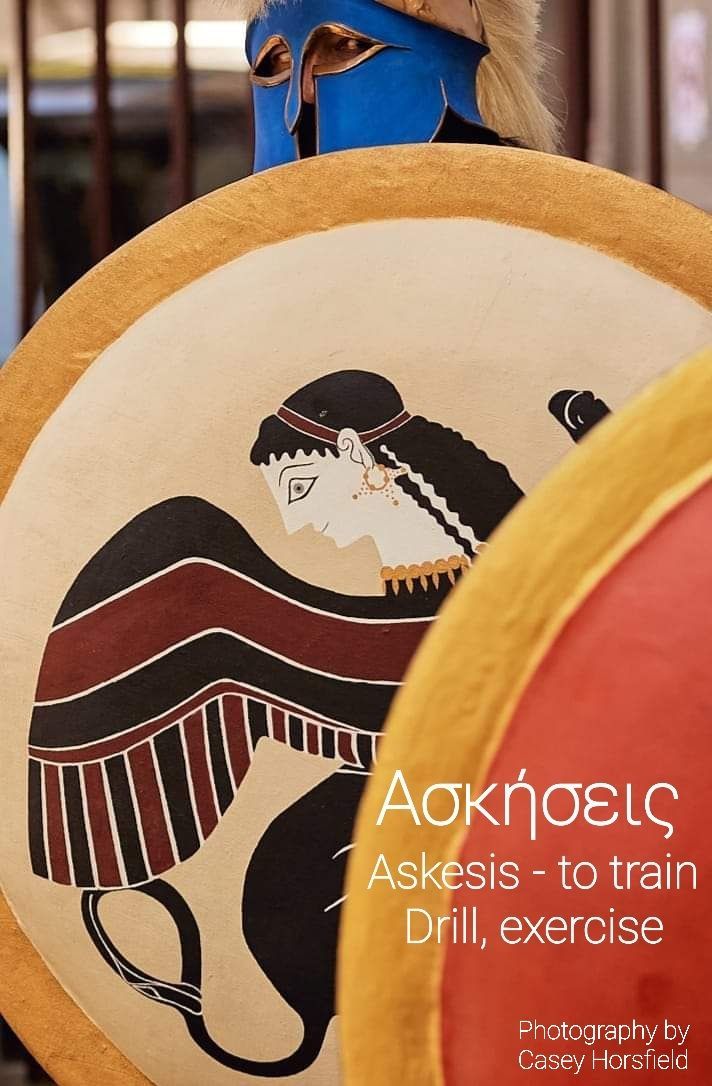
THE EPHEBIC OATH IN FIFTH-CENTURY ATHENS
Wherever a mans station is, whether he has chosen it himself in the belief that it is for the best, or he has been placed in it by his commander, there I believe he must remain and face the danger, taking no account of death or of anything else in comparison with disgrace.
Socrates words closely correspond to the epigraphic version of the oath ( I will not disgrace these sacred arms, and I will not desert the comrade beside me wherever I shall be stationed in a battle line) (and I will not hand over [to the descendants] the fatherland smaller, but greater and better, so far as I am able, by myself or with the help of all ).
Socrates speech is usually regarded as nothing more than a particular application to the personal experience of Socrates as a Hoplite citizen of the general principle that duty is more important than life.
In the early part of the 5th Century B.C. the young men in Athens registered in the Demes ( townships ) and entered a one year period of military training, following by another year of Garrison duty. Their moral conduct was observed by an elected board of Sophronistai ( Chasteners ). Those who stood the test became Ephebi, the others, if they failed in the test of age, were returned to the status of minors; but if they failed the test of birth they might either accept the verdict or exercise their right of appeal to a popular court. If the appeal failed he was sold by the city as a slave.
After completing his year of training, an Ephebi took an oath and was ceremonially presented with sword and shield. Ephebi were exempt from taxation and participated in important festivals. By the end of the 4th Century B.C. the Institution had spread throughout the Greek World and the Institution lasted until the end of the 3rd Century A.D.
ATHENIAN EPHEBIC OATH
I will not disgrace my sacred arms nor desert my comrade, wherever I am stationed. I will fight for things sacred and things profane. And both alone and with all to help me. I will transmit my Fatherland not diminished but greater and better than before. I will obey the ruling magistrates who rule reasonably and I will observe the established laws and whatever laws in the future maybe reasonably established. If any person seek to overturn the laws, both alone and with all to help me, I will oppose him. I will honour the religion of my Fathers. I call to witness the Gods Agravlos, Hestia, Enyo, Enyalios,Ares and Athena, Ariea, Zeus, Thalo. Auxo and Egemoni, Herakles. The borders of my Fatherland, the wheat, the barley, the vines and the trees of olive and the fig.
(In the Ancient Athenian Deme (township) of Archarnae a fourth-century stele on which was engraved `in dubitable letters of stone the true, Ancient, Authentic and official wording of the oath. 334/3 B.C. )
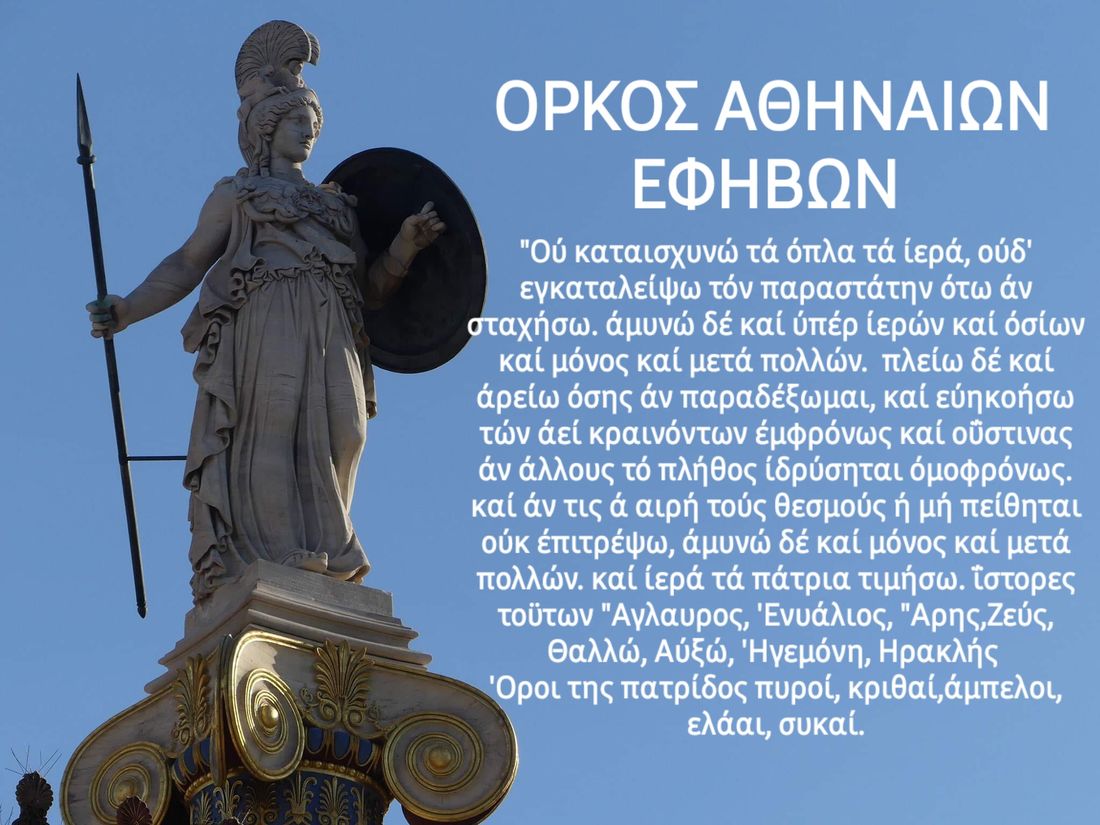
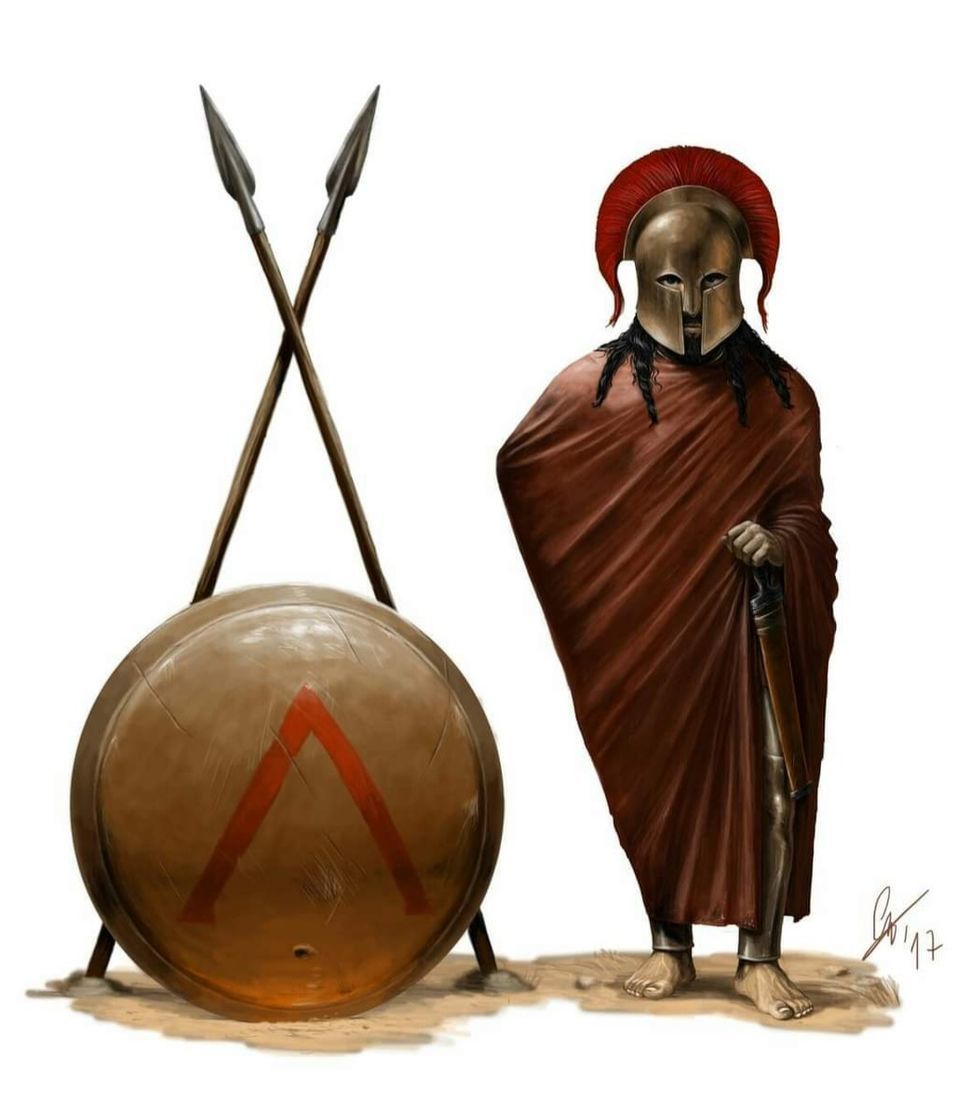
PYRRHIC DANCE
The Pyrrhic dance in armour was a popular element in Ephebic training and usually at religious festivals. It originated in Archaic times as a means of training young warriors in the moves required to avoid enemy blows and to deliver their own.
The origin of the Pyrrhic dance comes from Pyrrhus (PURROS) `The Redhead, The Surname of Neoptolemus(NEOPTOLEMOS) `Young Warrior, Son of Achilles. After his Fathers death at Troy, he was brought to fight on the Greek side. Neoptolemus killed Eurypylus a Trojan and in his delight he invented the PYRRHIC WAR DANCE which is named after him. He was among the Heroes who entered Troy in the Wooden Horse.
(PURRICOS) Pyrrihcus reputed inventor of the Pyrrhic war dance performed with spear and shield, came from a town called Pyrrhus in Laconia, Sparta.
TYRTAEUS c.650B.C.
| The Spartan Paian Go forth, children of citizens of Sparta, the land of brave men. With left hand the shield put forward firmly, the spear raise with your right. Go forth and show your courage without fearing for your life, cause fear for ones own life does not become to Spartans.
| O SPARTIATIKOS PAIAN 650p.c. O PAIAN POU EYALLAN OI SPARTIATES POLEMISTES KAQWS BADIZAN KATA TOU ECQROU: AGETE, W SPARTAS EUANDRW KWROI PATERWN POLIATAN, LAIA MEN ITUN PROBALESQE DORU D~EUTOLMWS ANSCESQE MH FEIDOMENOI TAS ZWAS. OU GAR PATRION TA SPARTA. APODOSH STH NEOELLHNIKH: EMPROS W THS EUANDROU SPARTHS TEKNA PATERWN POLITWN, DIA THS ARISTERAS CEIROS THN ASPIDAN PROBALETE, DIA DE THS DEXIAS ME TOLMH TO DORU UYWSATE, MH FEIDOMENOI TIS ZWES GIATI AUTO DEN EINAI PATROPARADOTO STN SPARTA! |
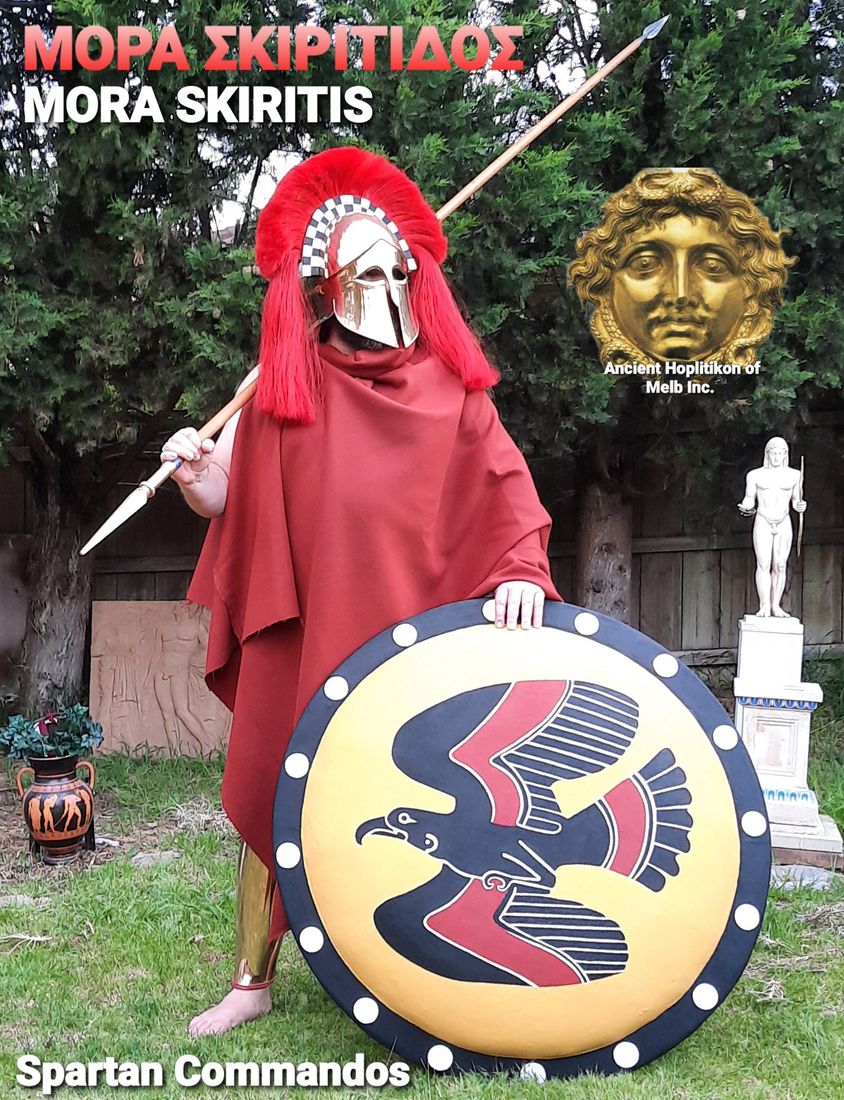
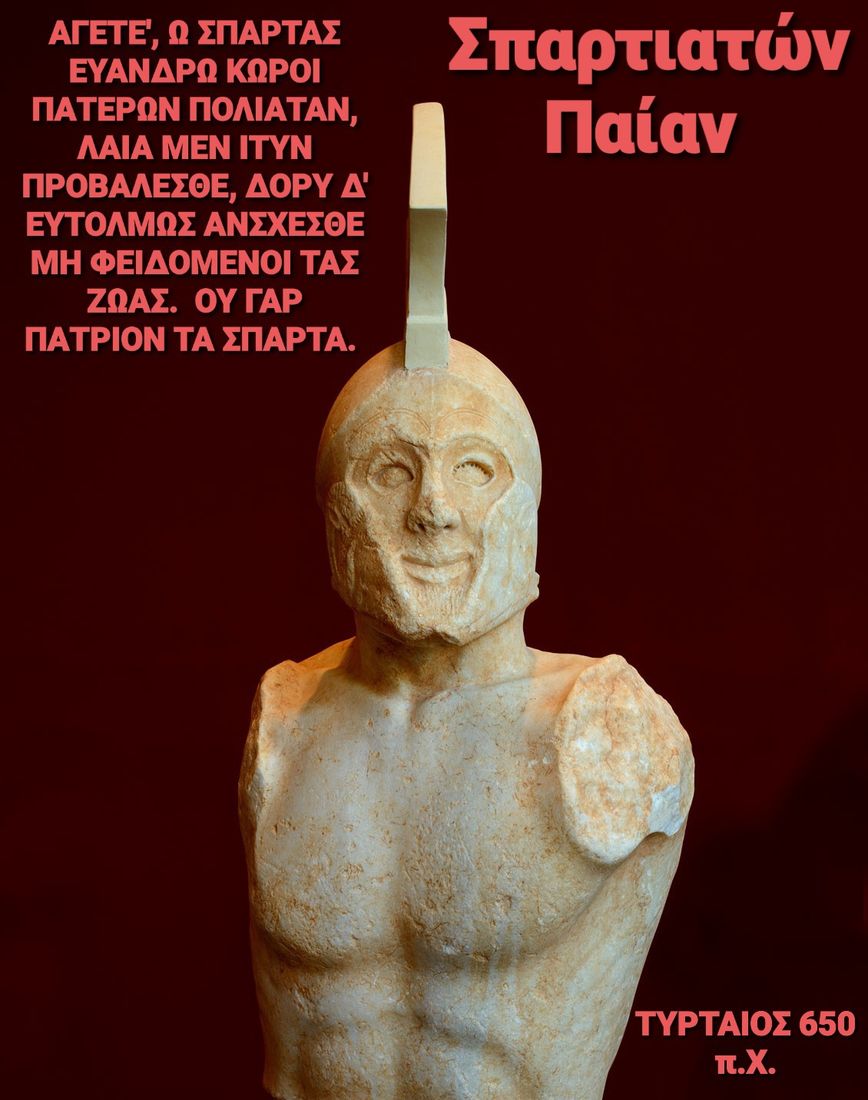
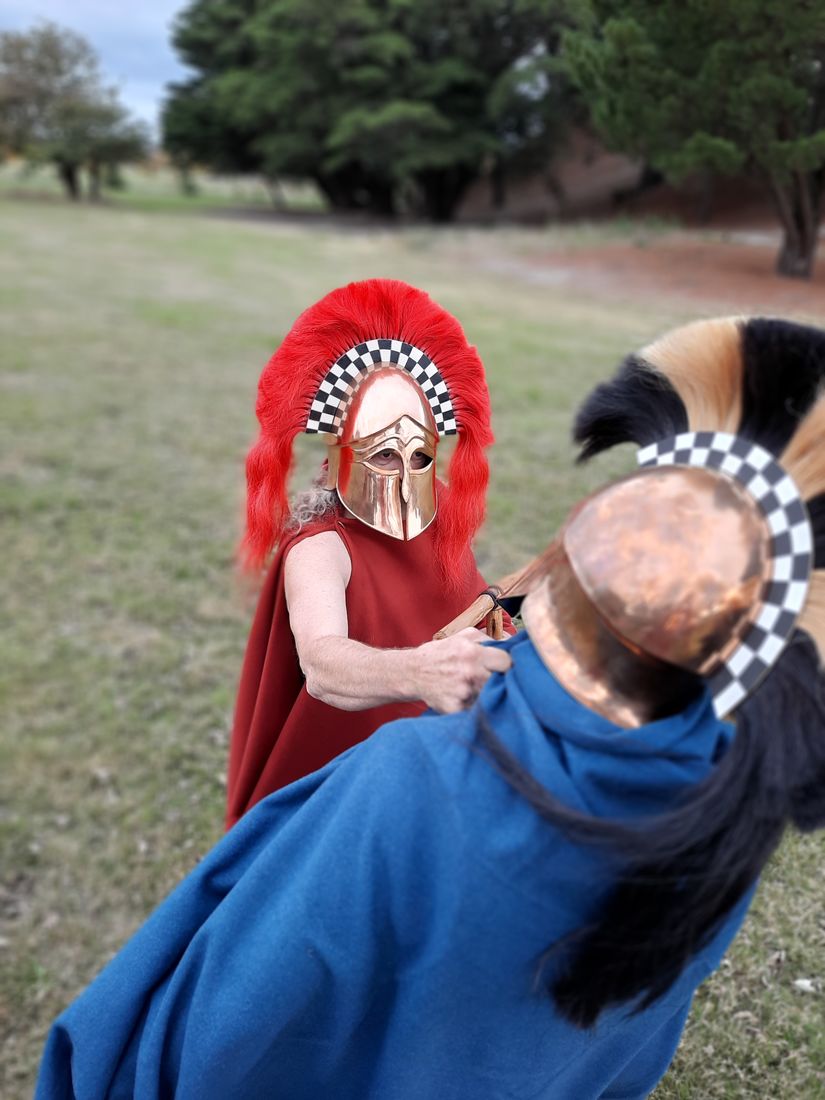
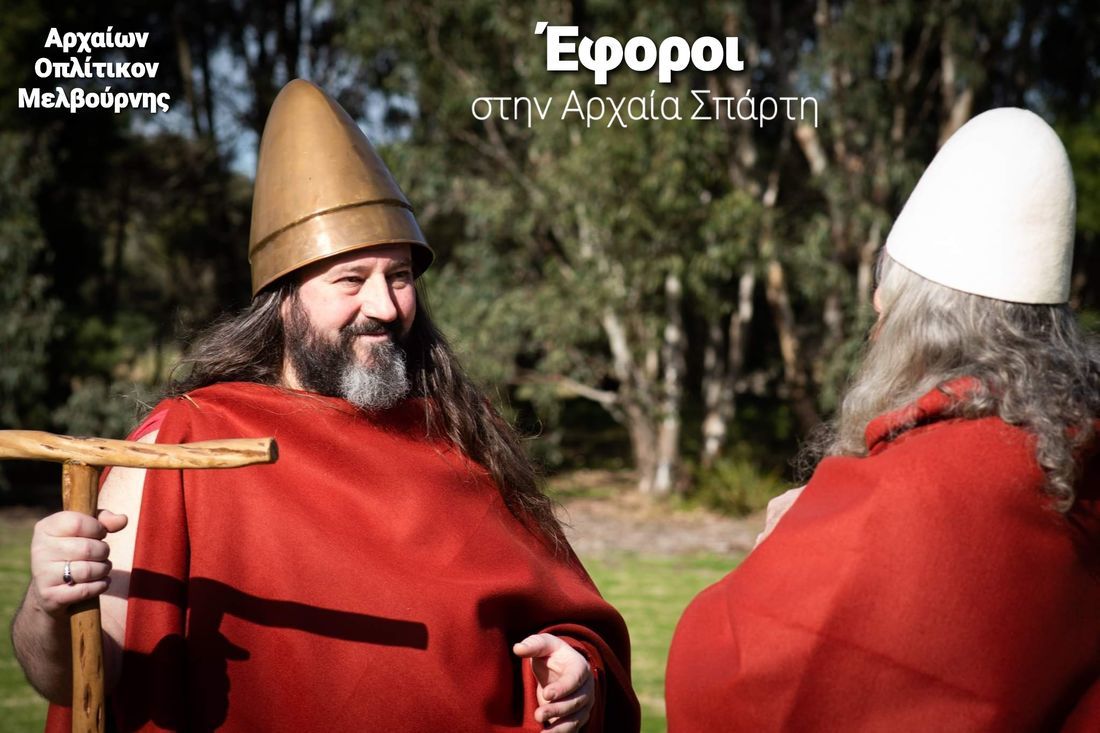
"War is the father and king of all, and has produced some as gods and some as men, and has made some slaves and some free". Heraclitus of Ephesus.
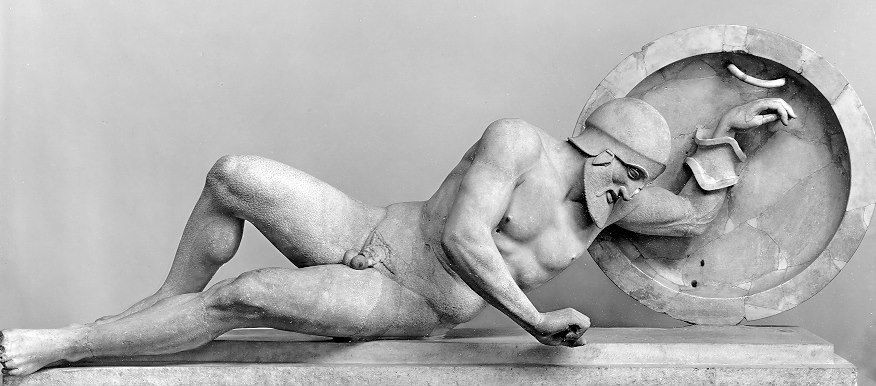
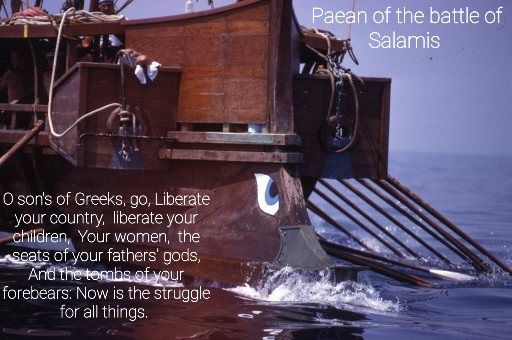
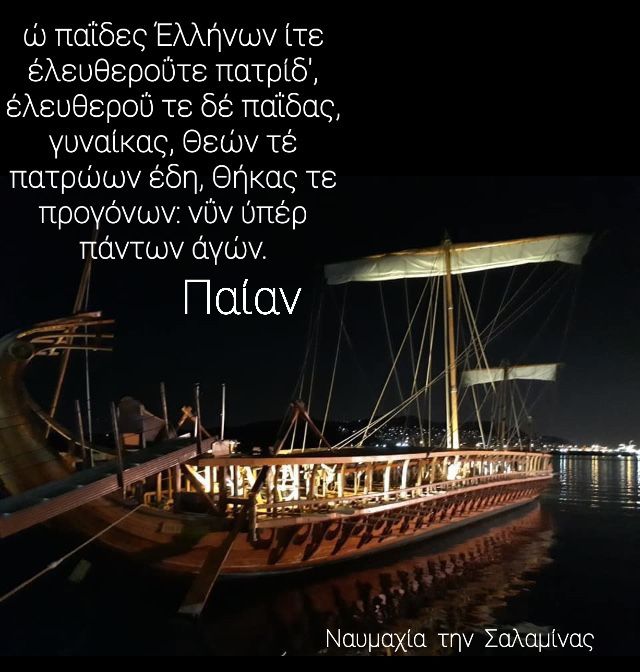
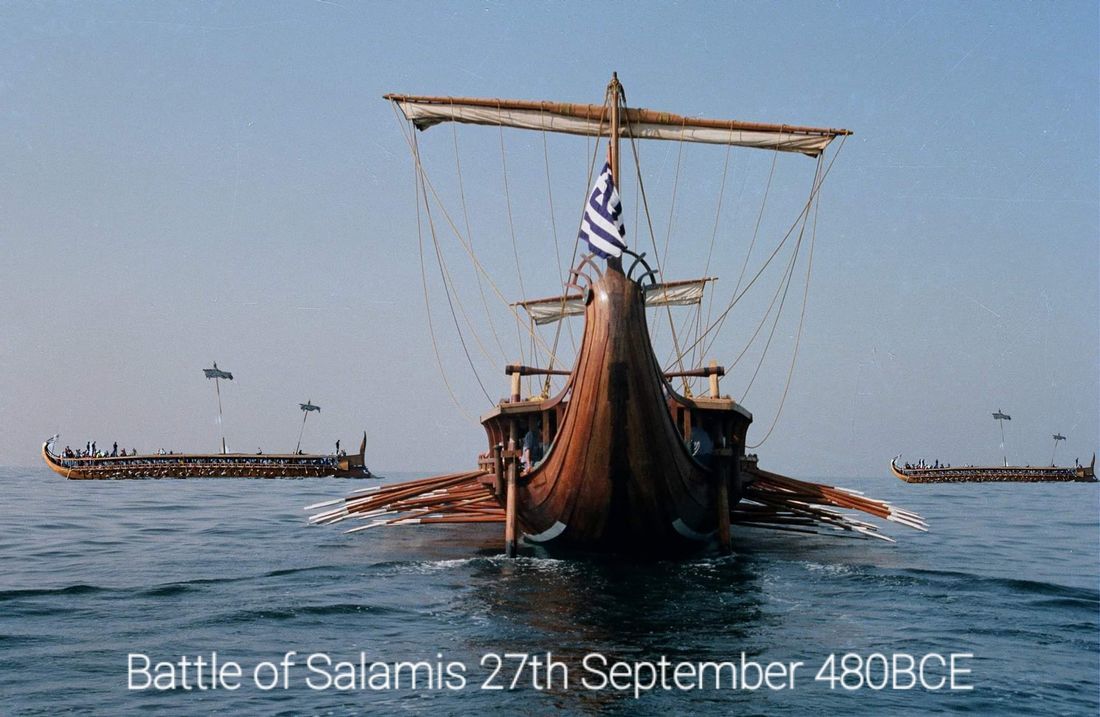
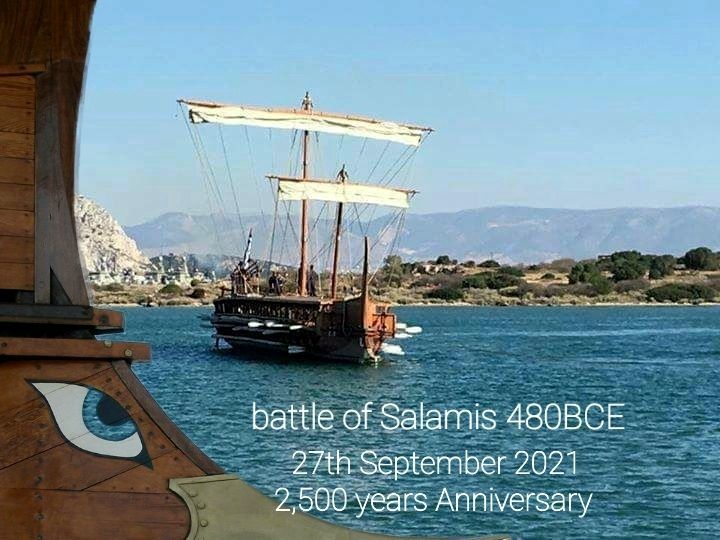
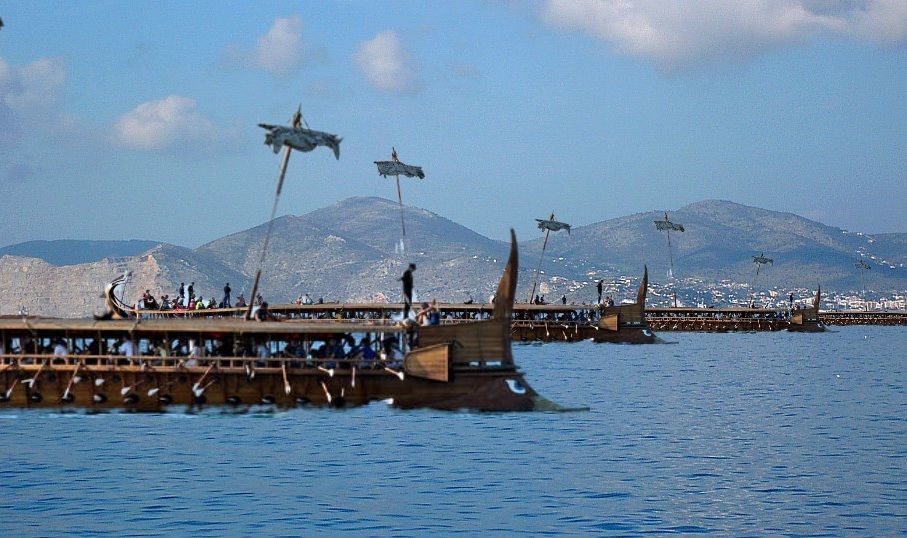
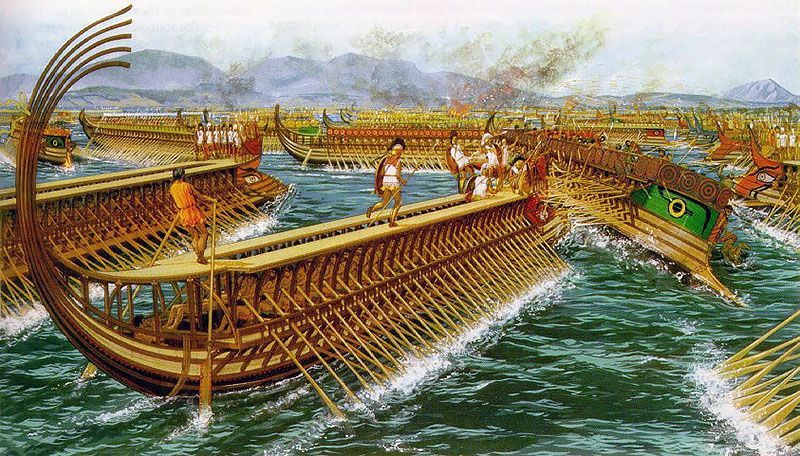
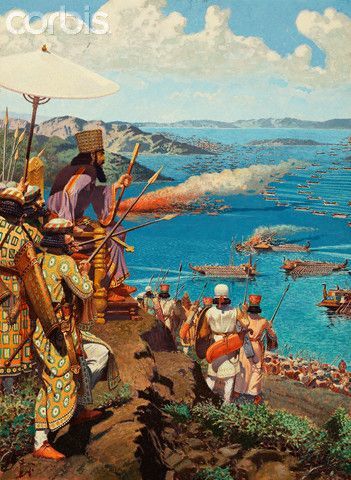
"Rule only when you have learnt to obey; for having learnt to obey you will know how to rule". Solon of Athens "Praise no man until you see his death!". Sophocles "Courage is of no value unless accompanied by justice; yet, if all men became just, there would be no need for courage". Agesilaus king of Sparta
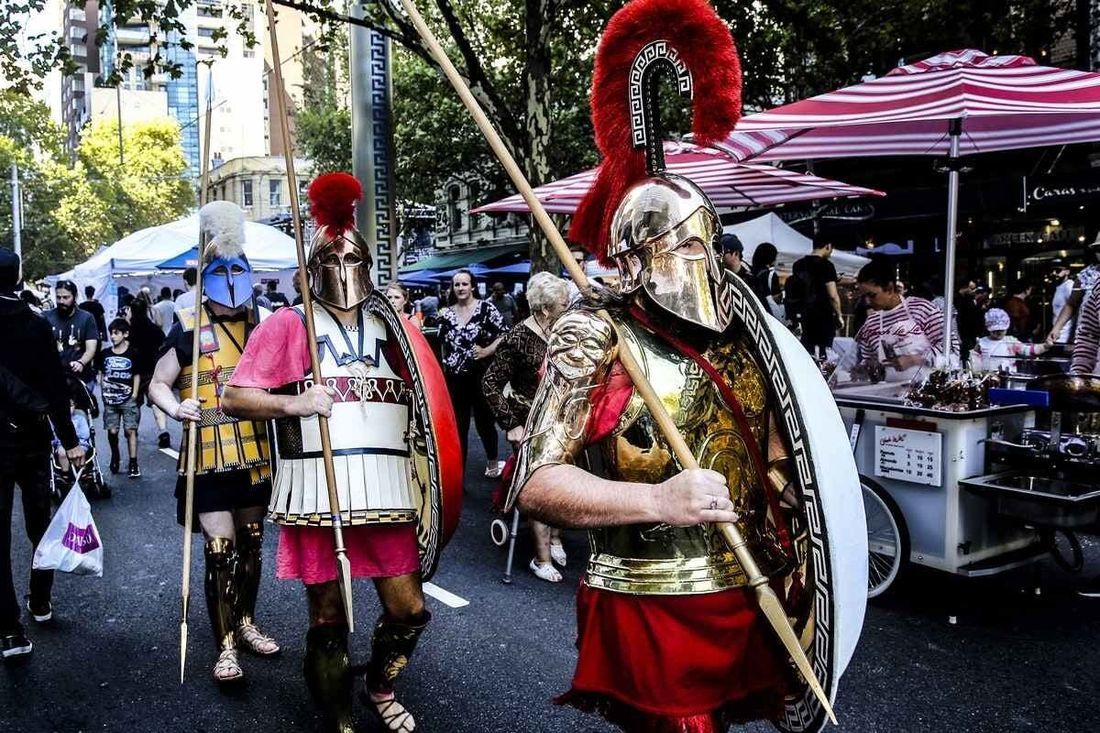
( Swordsmanship)
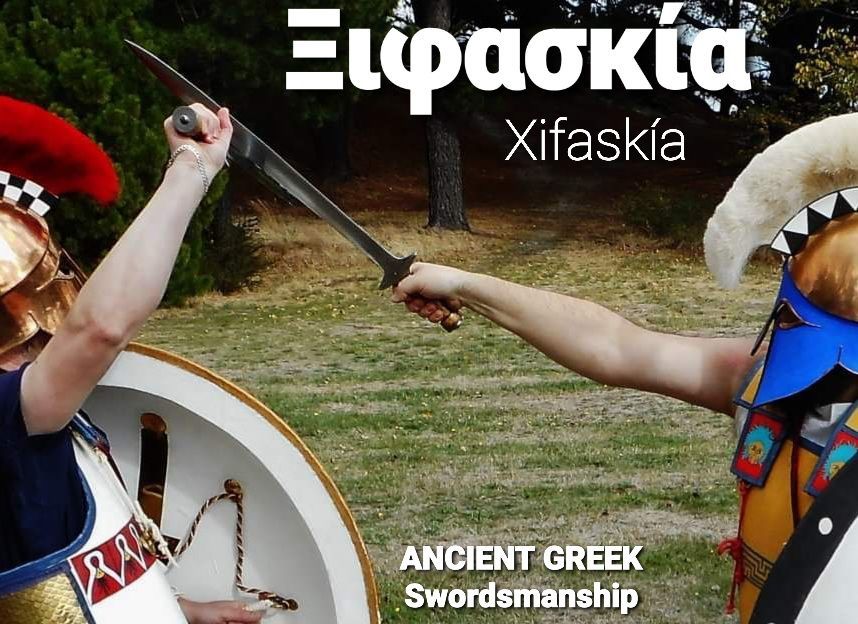
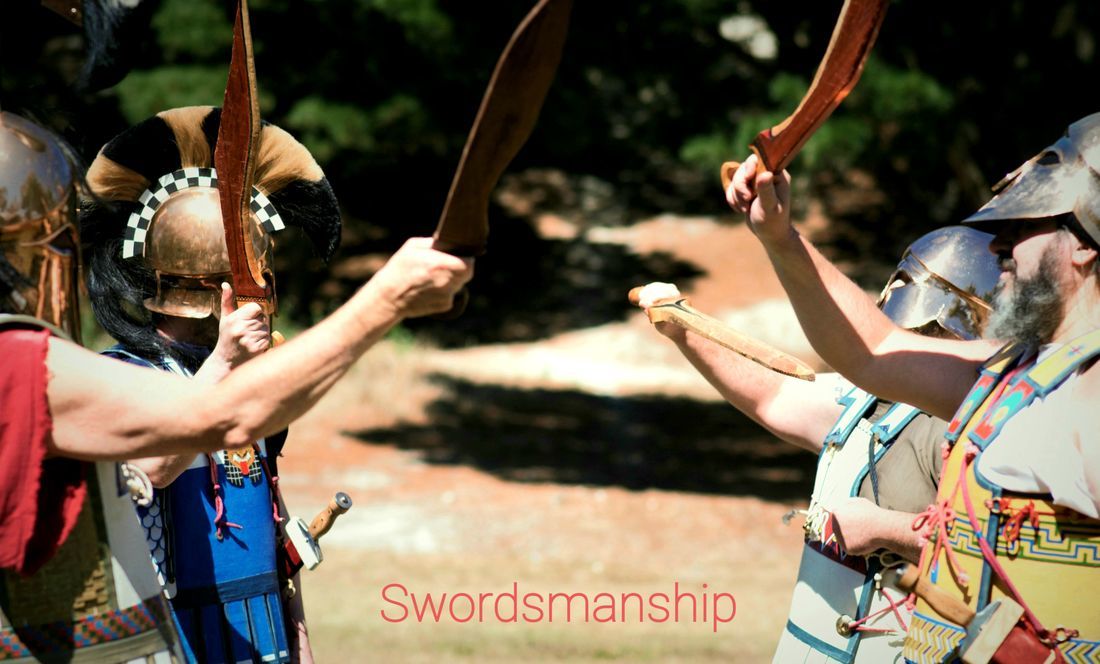
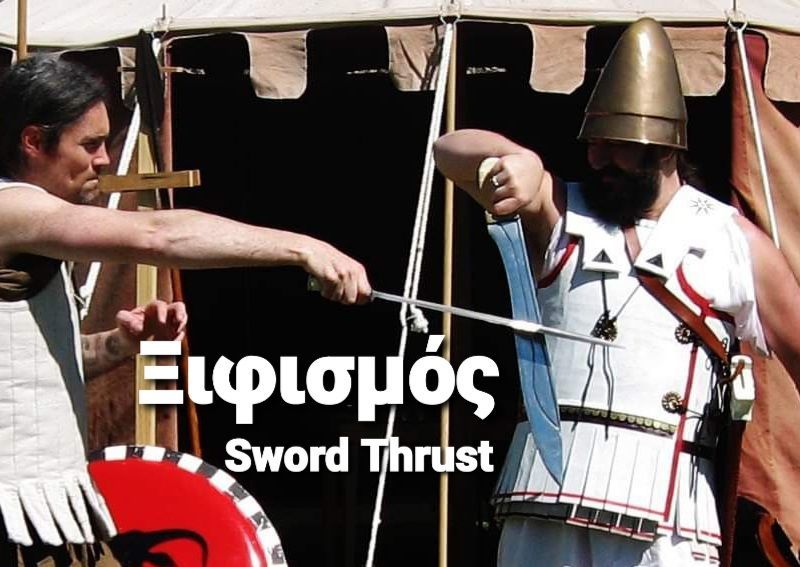
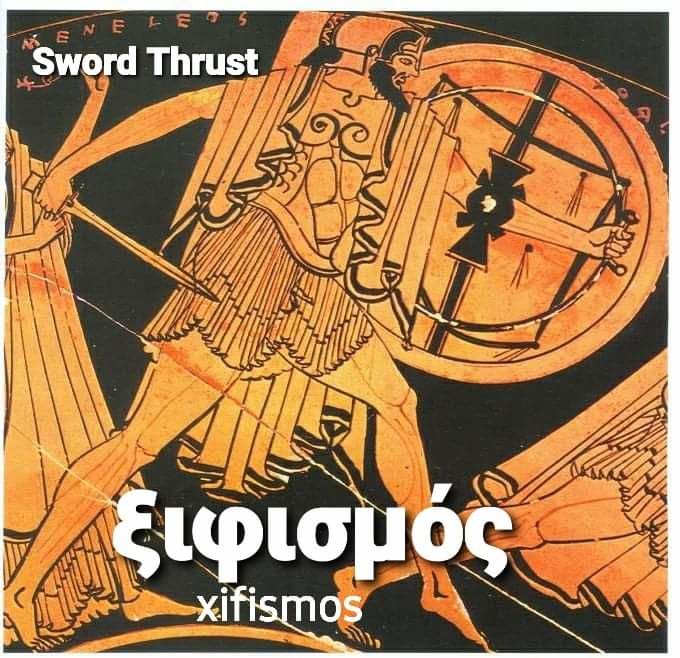
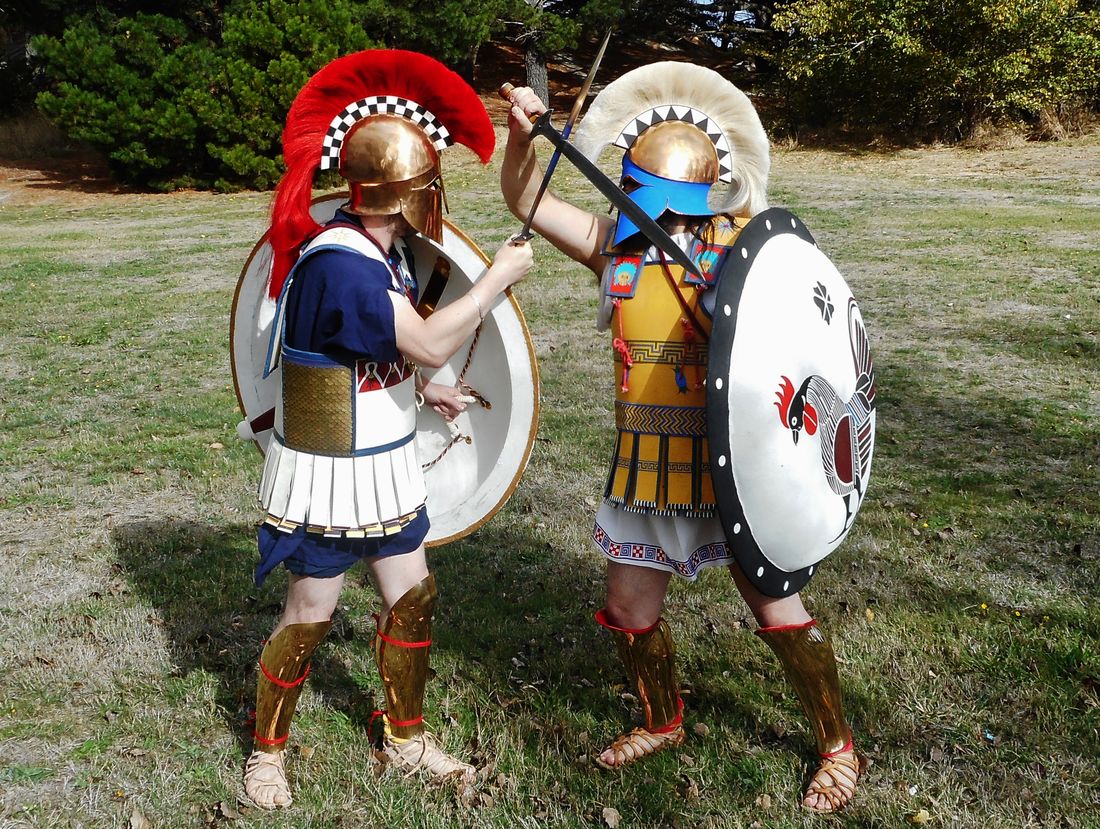
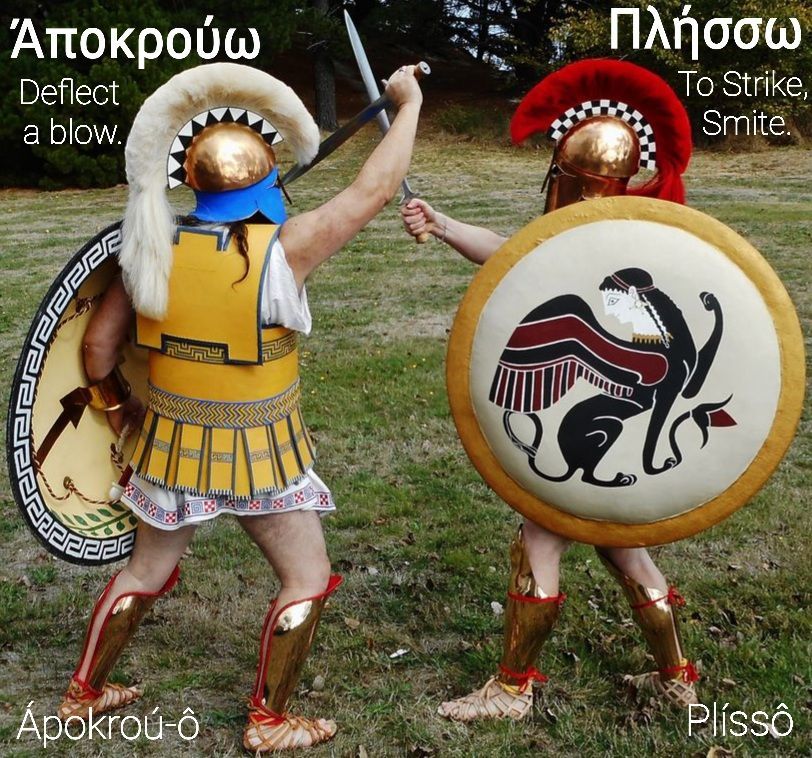
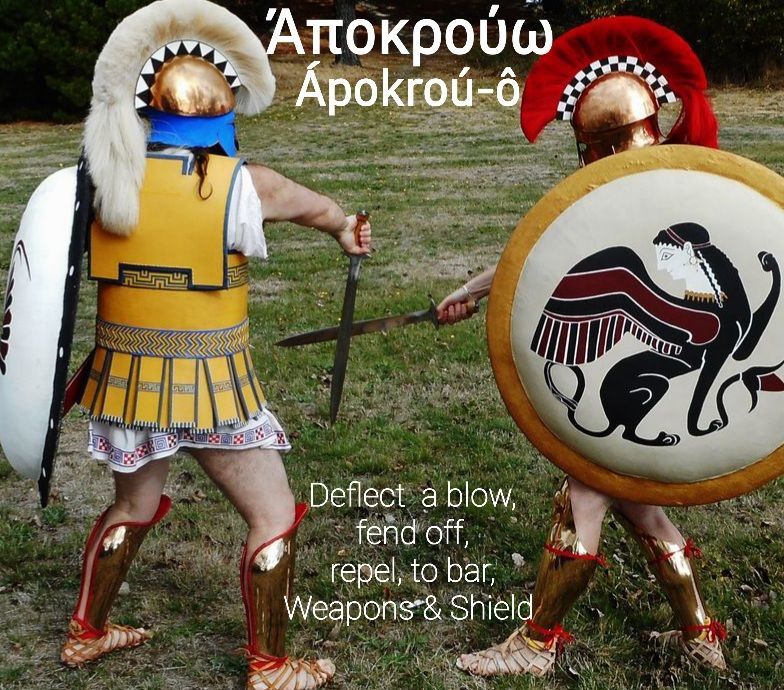
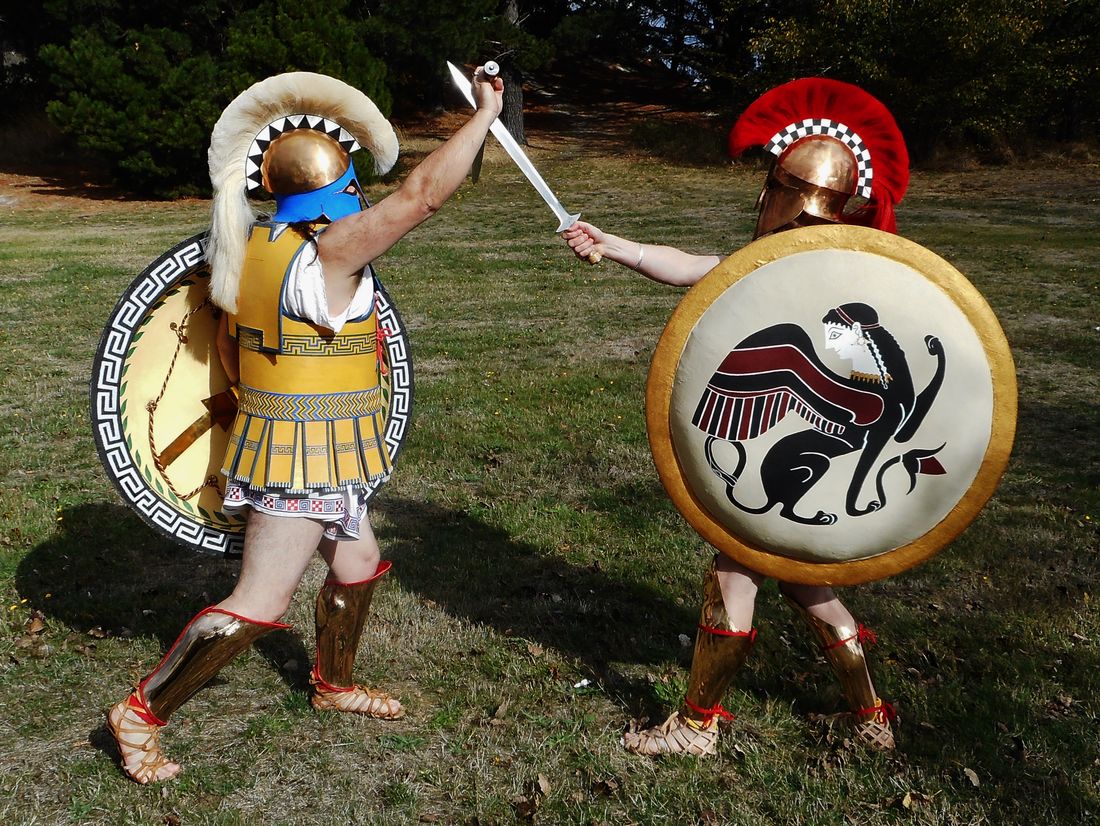
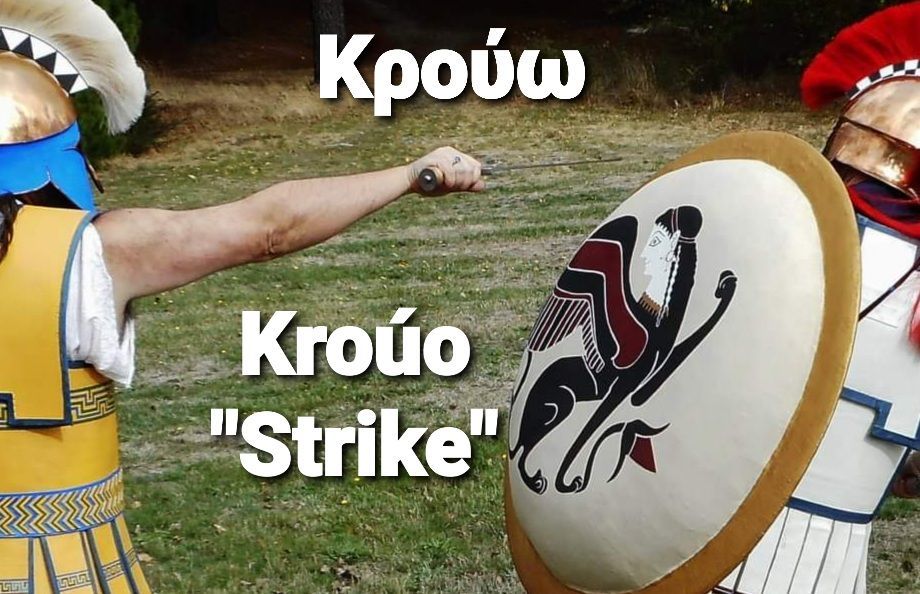
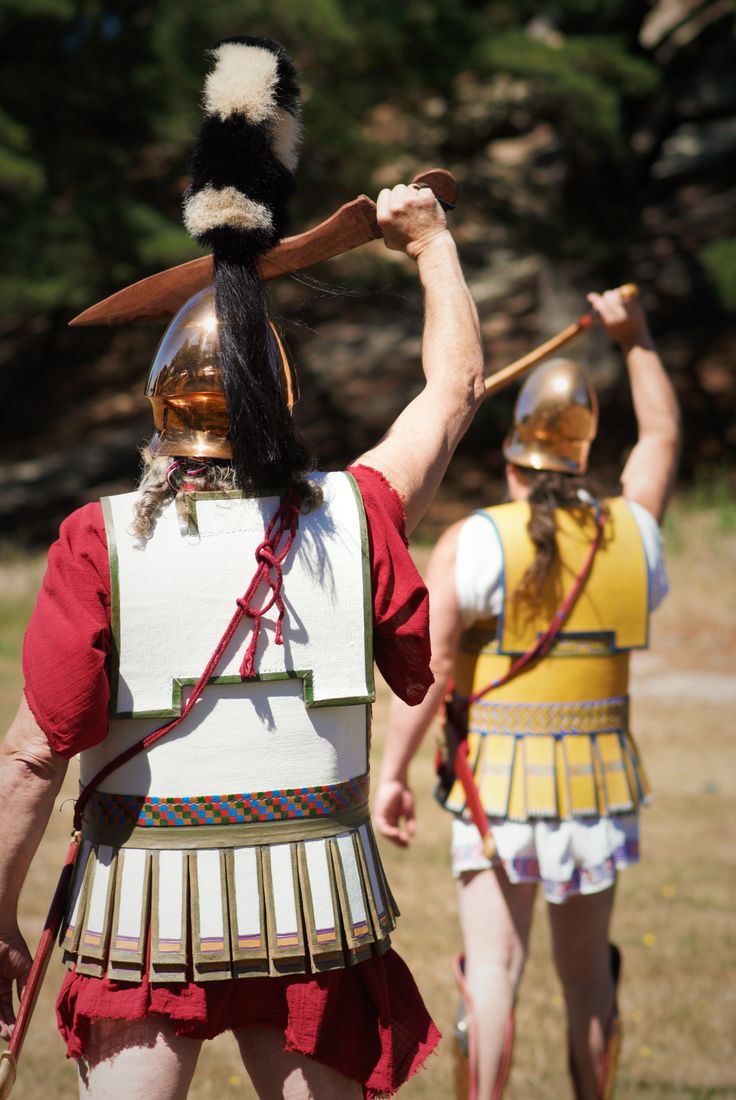
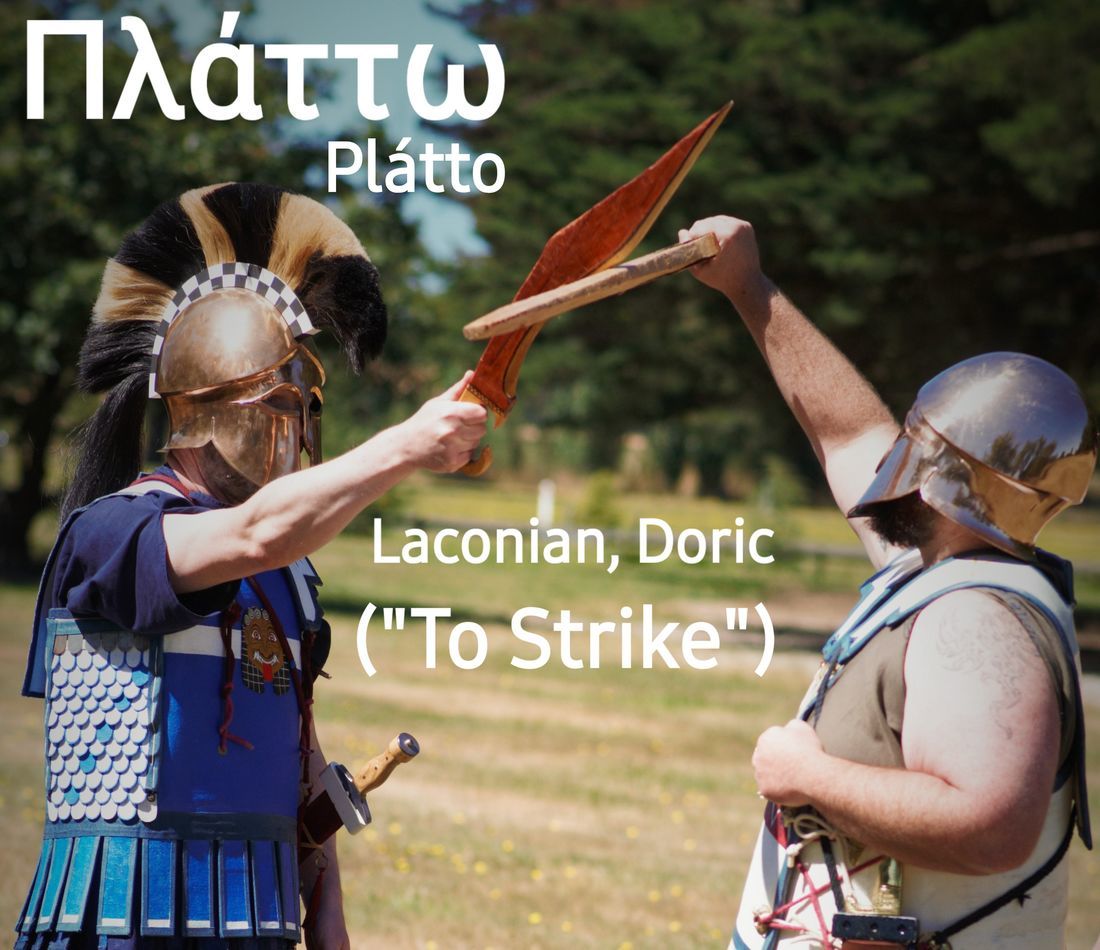
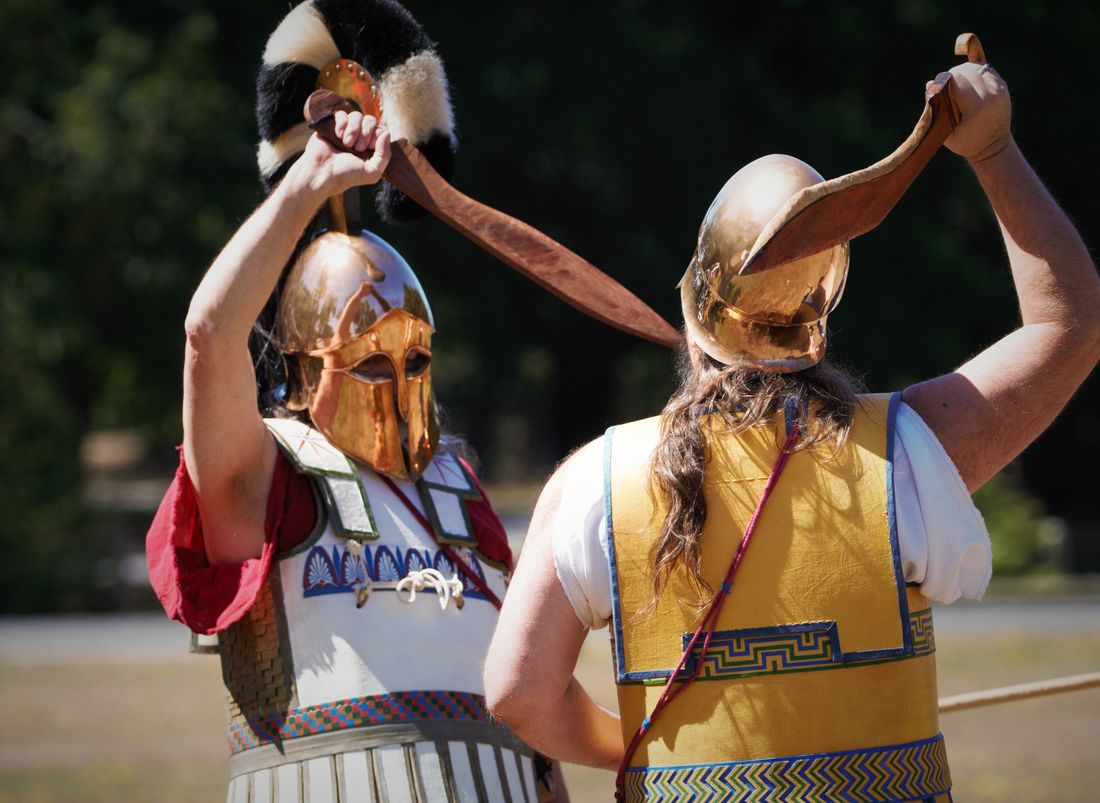
"Daily Life of Hoplites in Greek Antiquity", War formed the backdrop of centuries of Greek Civilization. The unique practice of Ancient Greek warfare explain's how the rise of Western Civilization and many of it's institutions were originally an integral part of the conduct of war. The List of notable Greeks at war contains name after famous name of philosophers, playwrights, poets, historians - all of whom, at one time or other, had killed in hand to hand fighting. Aeschylos, Sophocles, Socrates, Perikles, Demosthenes, Thucydides and Xenophon each fought in battle armed only with spear and shield as citizen militia.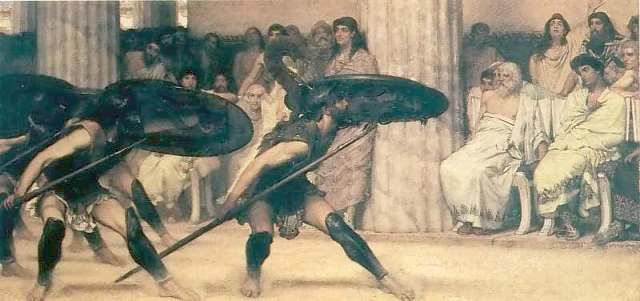
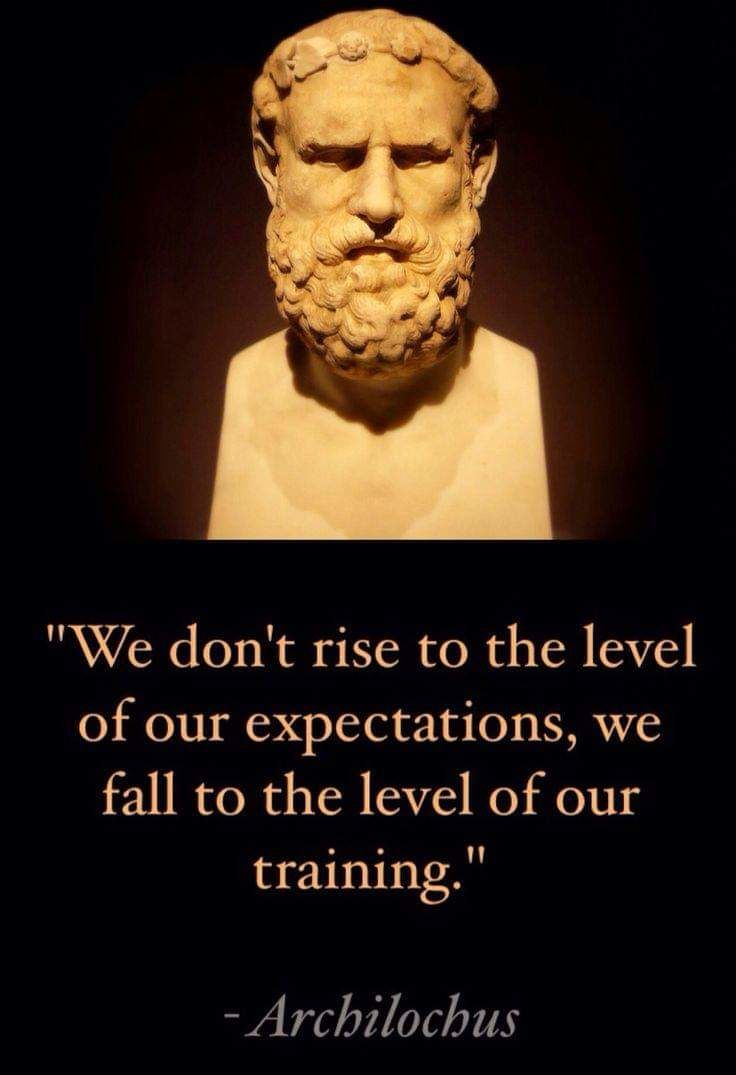
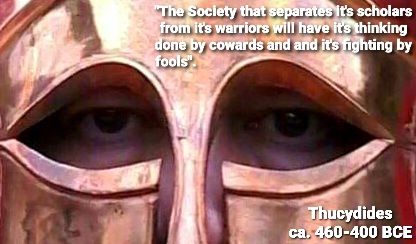
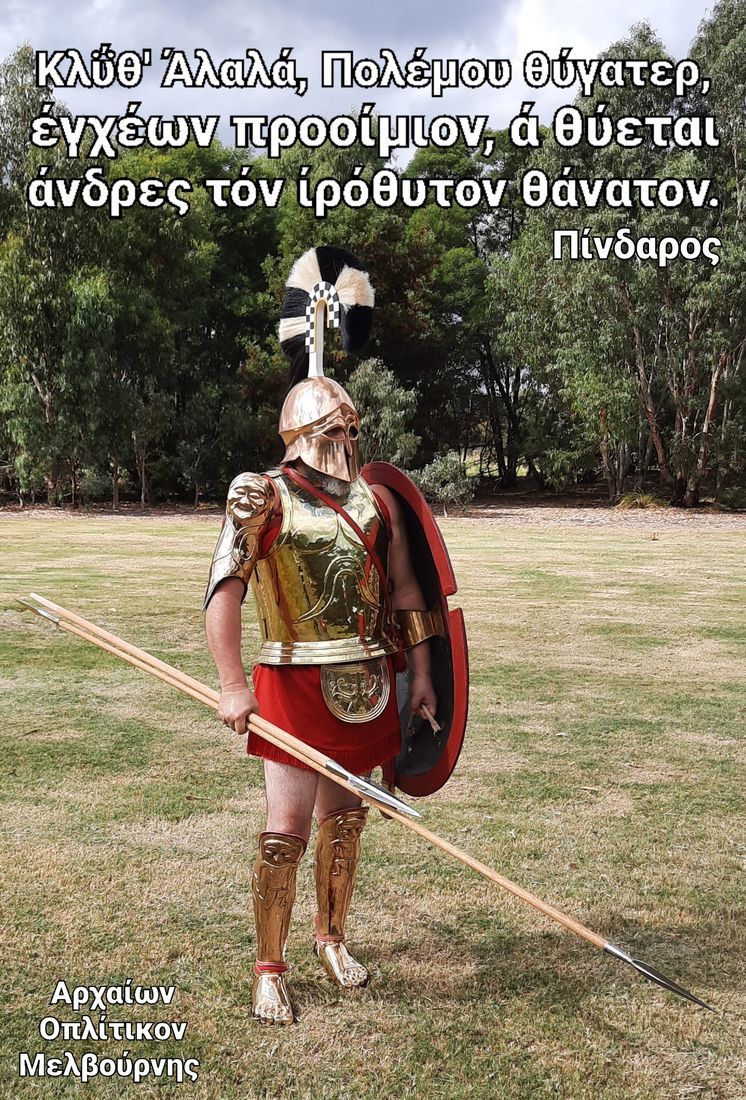
"Hear me, O 'Alala, Daughter of Polemos,
Prelude of Spears, to whom men fall as
offerings for their Homeland, as death's
holy sacrifice".
Pindar 518 BCE - 438 BCE
Ancient Greek Lyric Poet from Thebes
Spoon of Diocles
Homer's Iliad, introduces the term IATROS, which means "He who extracts Arrows".
Diocles of Carystus from the island of Euboea, 375-300 BCE. Belonged to the Sicilian school of Medicine, Diocles was also a pupil of Aristotle.
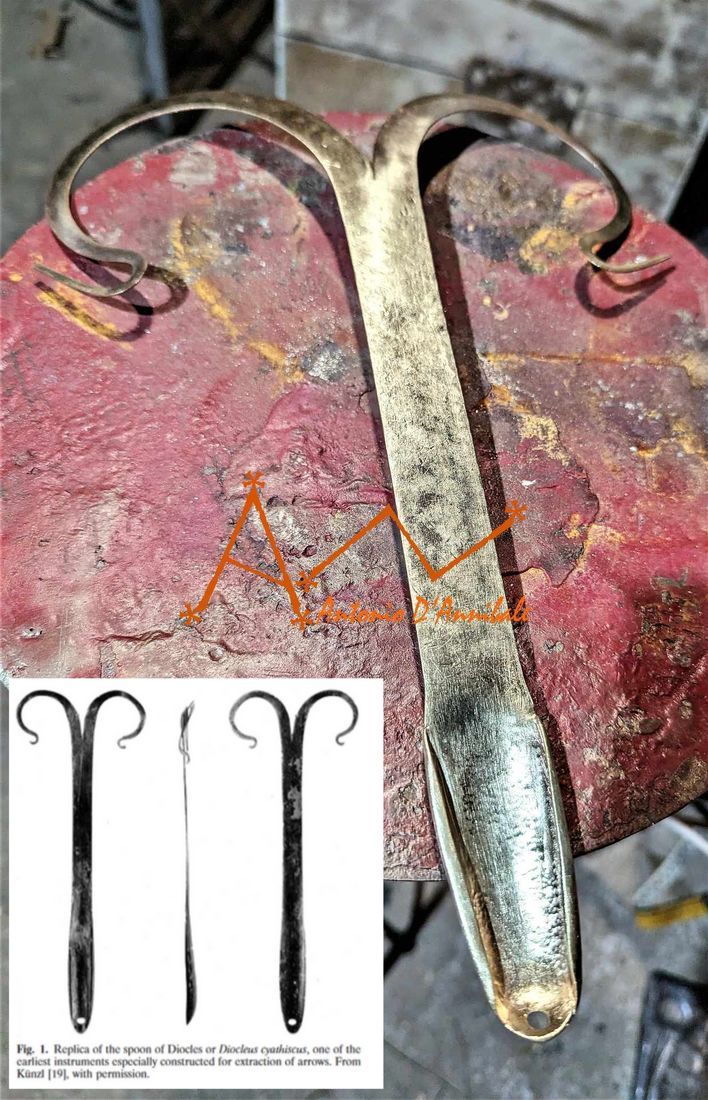
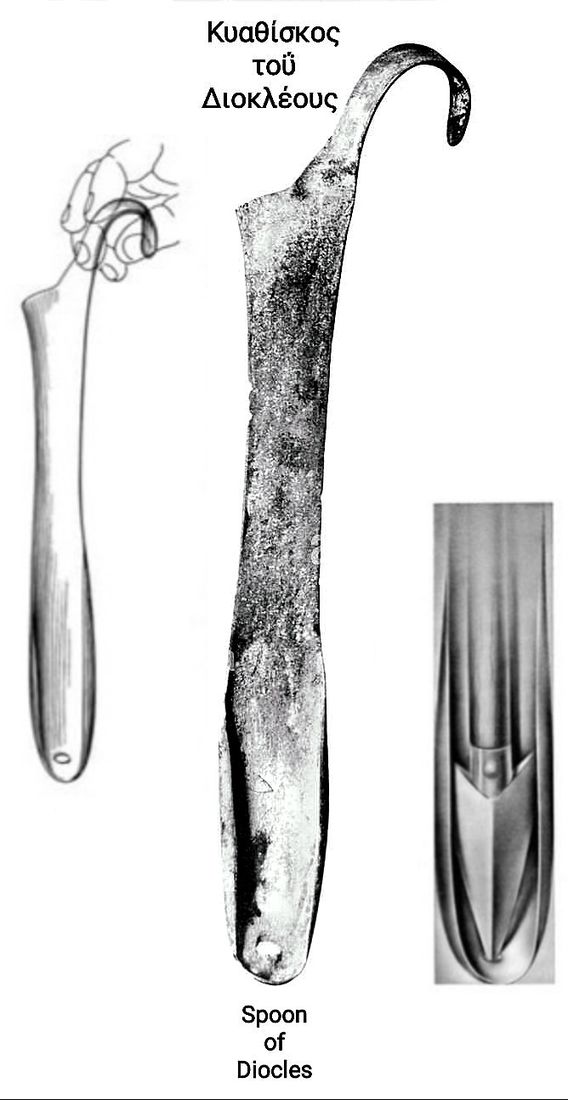
An Ancient Surgical instrument described by Celsus.
The instrument was designed by Diocles of Carystus, to remove Barbed Arrows from the human body. The instrument was used to remove the injured eye of Philip II of Macedon without disfiguring him.
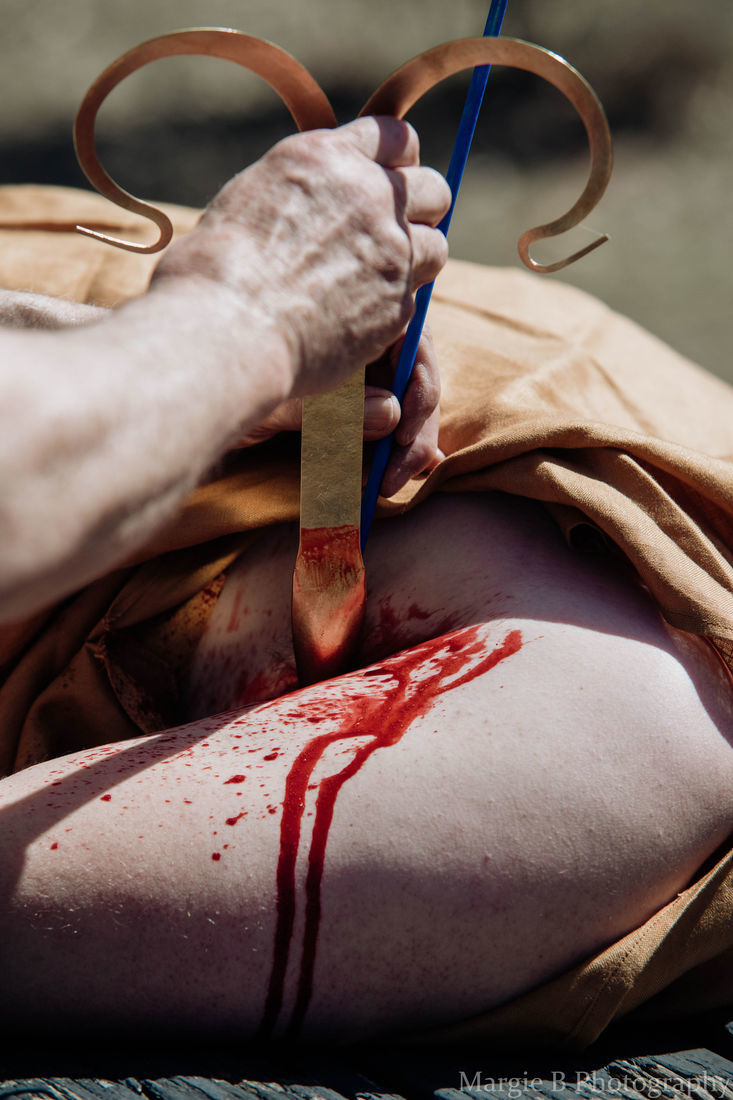
Injuries sustained during battle in the Ancient World would have been quite distinct from those encountered in modern warfare and obviously required different approaches. The absence of effective Anaesthesia would have also been an important consideration for the Roman Surgeon, Celsus wrote that:
If it is a broad weapon which has been embedded, it is not expedient to extract it through a counter opening, les we add a second large wound to one already large. It is therefore to be pulled out by the aid of some such instrument as that which Greeks call the Dioclean Cyathiscus.
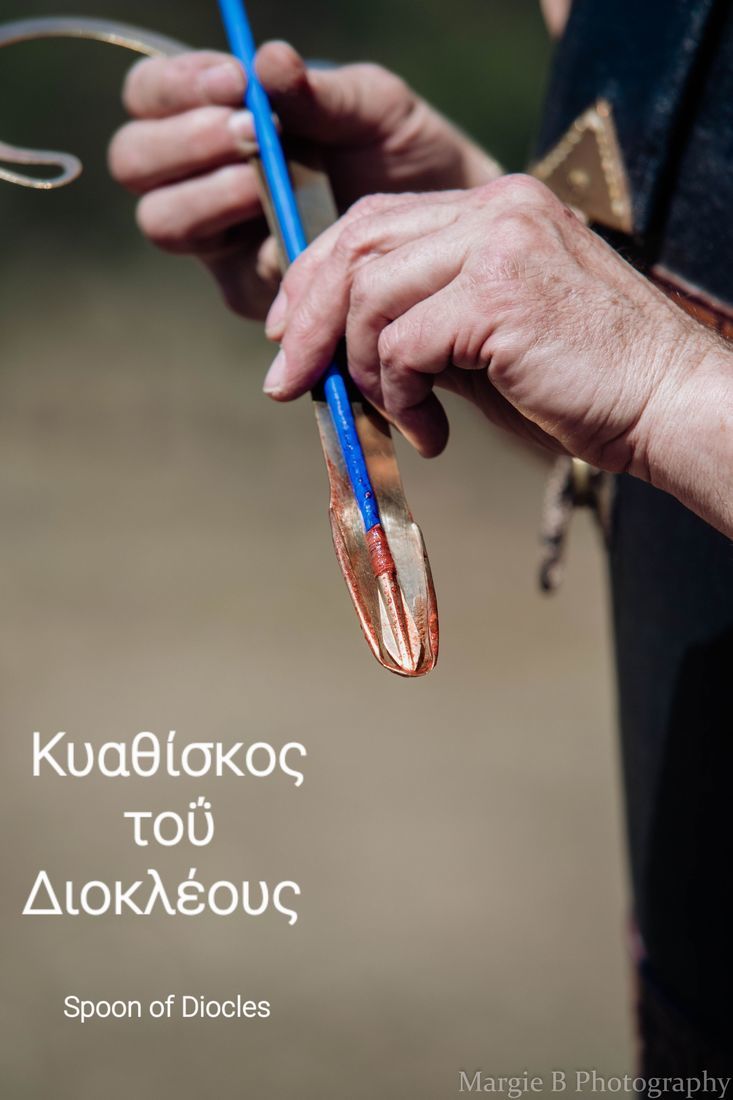
Majno suggests that this was a Spoon-Shaped object with a small hole at the base to take the point of Spear or Arrowhead. It would have been passed down into the wound and then rotated slightly to accommodate the weapon, which could have then been withdrawn. The repair of a simple flesh wound was the most commonly performed surgical procedure in the Ancient World. It would have been undertaken by Doctors but also a range of other individuals such as a family member, in the case of the Army, a fellow soldier . Basic Surgical kits consisted of Probes, Hooks, Forceps, Needles, Cautery tools and Scalpels were certainly readily available.
"Greco-Roman Medicine & What it can Teach us"
Nick Summerton
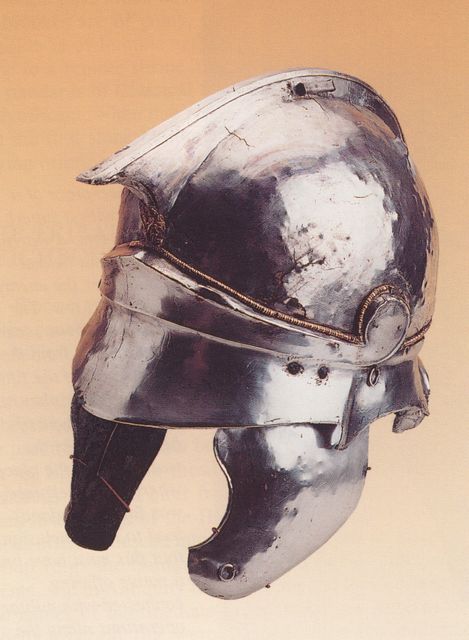
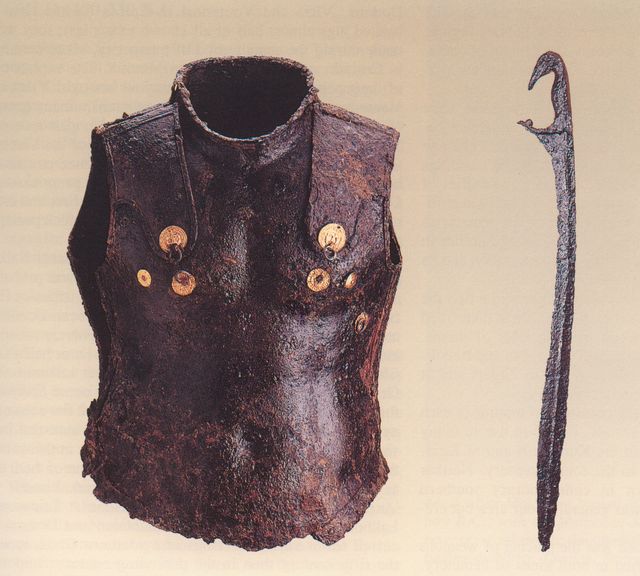
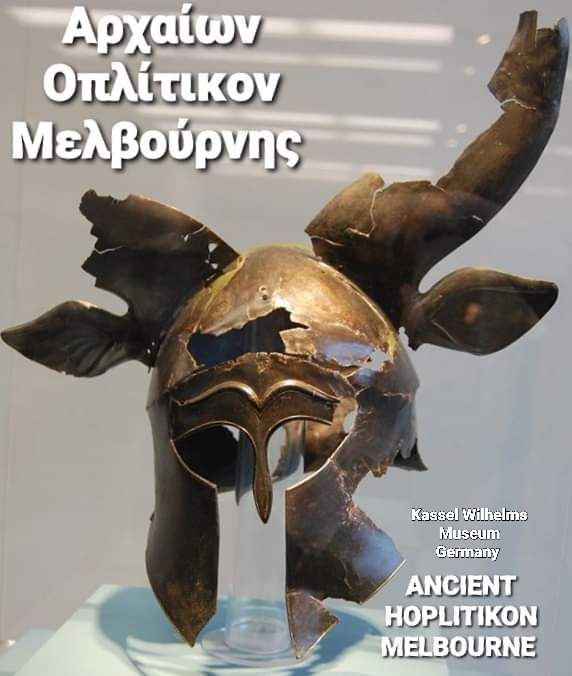
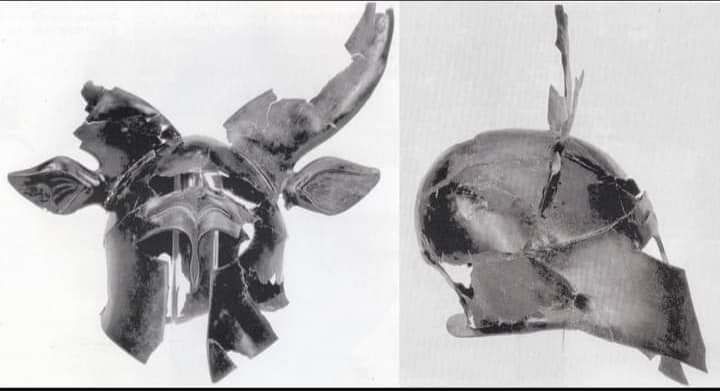
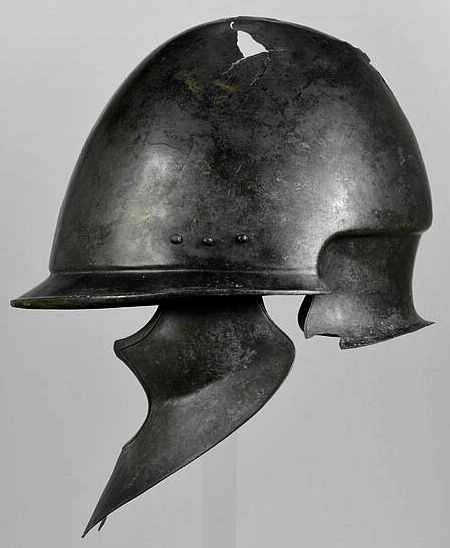
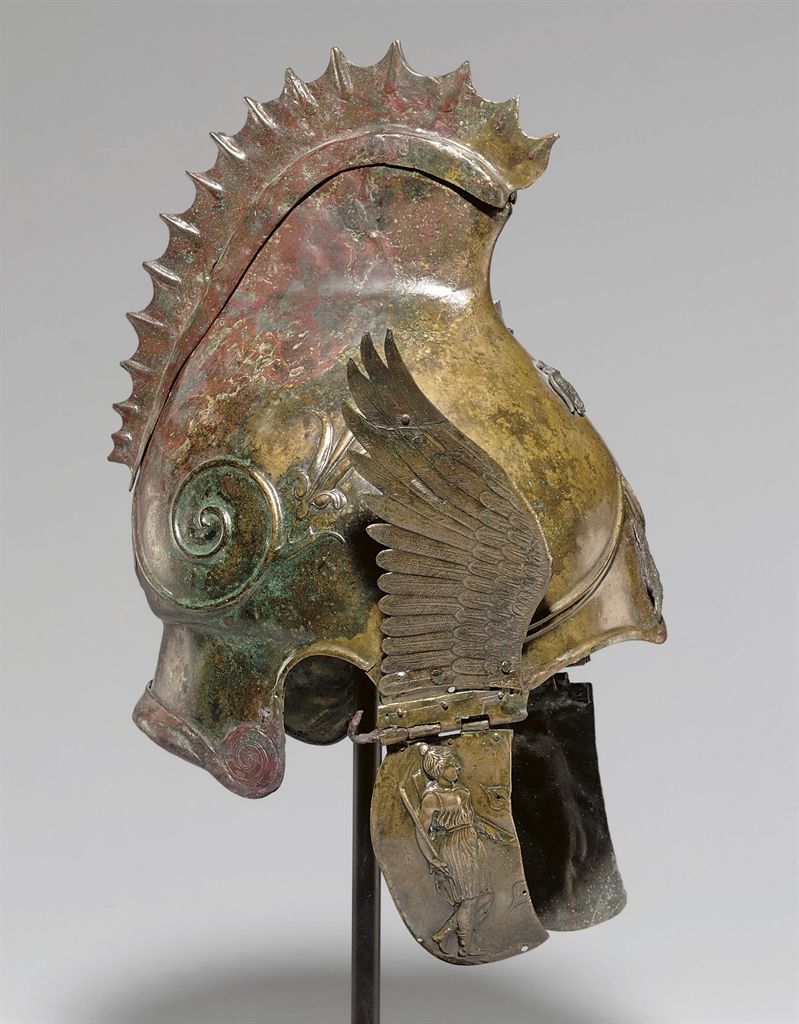
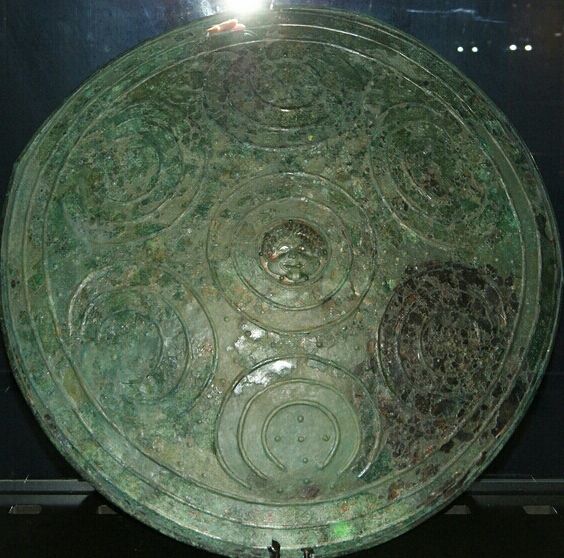
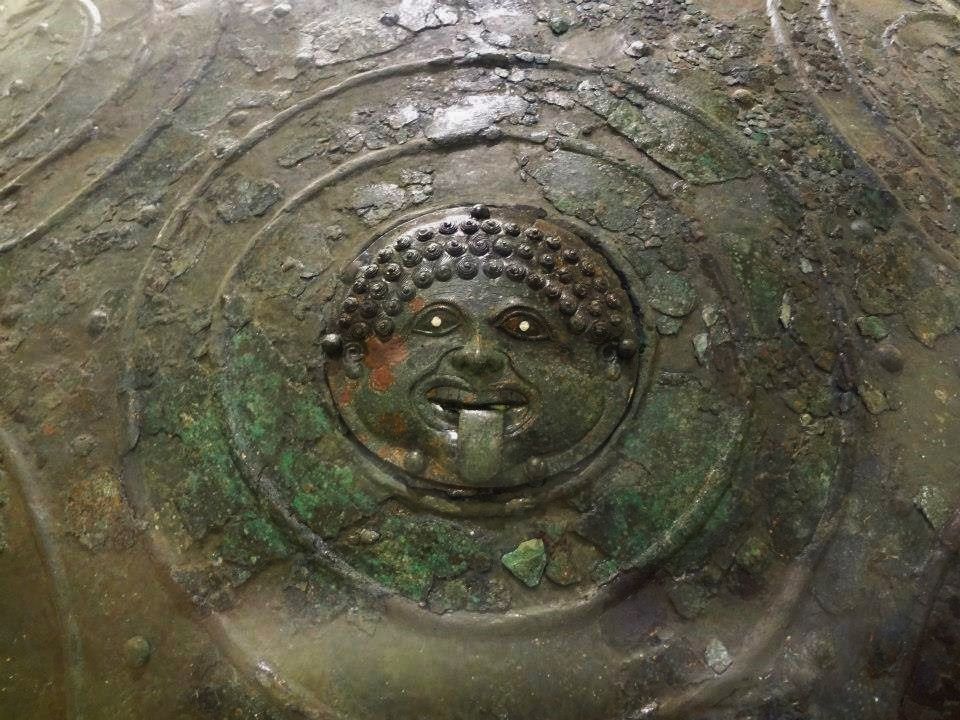
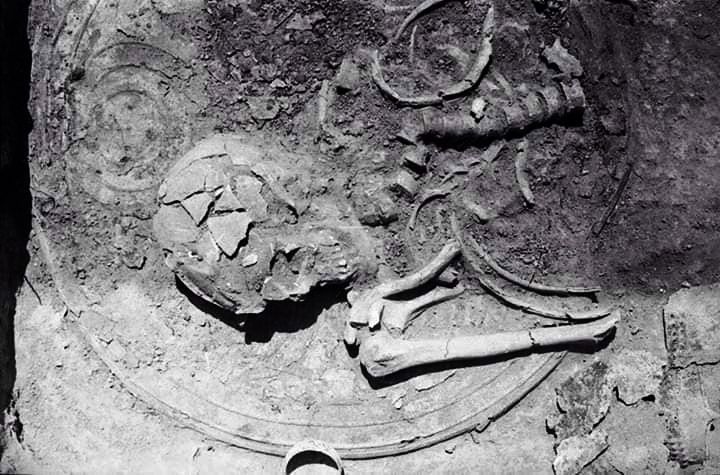
MACEDONIAN Warriors tomb, Laid over his Pelta Shield, Hellenistic Period. Excavated 1983 in Albania.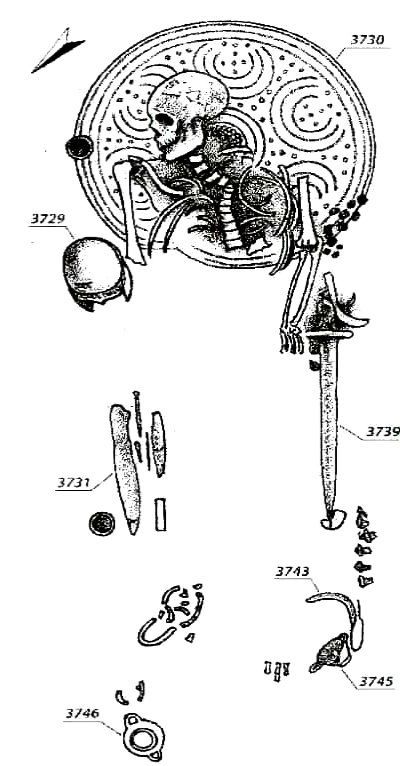
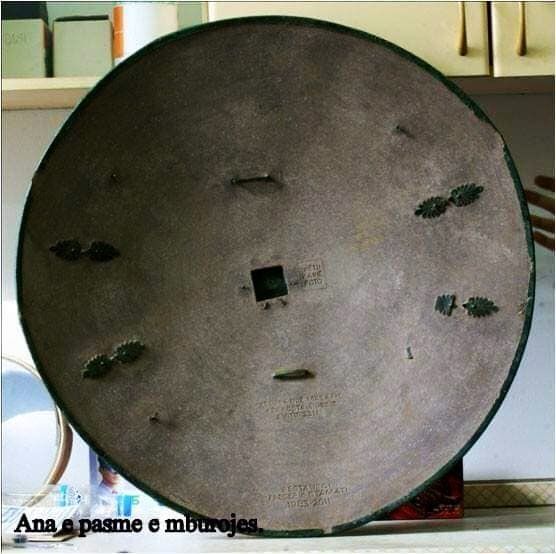
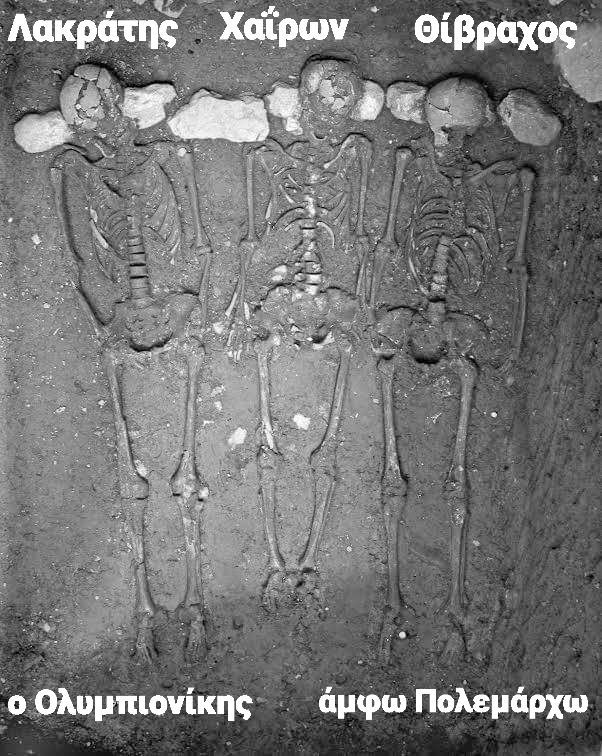
Three different Spartans (Lakedaimonians) that are interred at the Kerameikos in Athens. The names of three revered men are: LAKRATIS, "CHAIRON & THIVRACHOS".
LAKRATIS was an Olympic Victor in 416 BCE at an unknown event. He is tentatively indentified as the individual on the far left.
CHAIRON & THIVRACHOS , both were Polemarchs (War Leaders). All three were killed, along with Twenty-three other Lakedaimonians, in 403 BCE when Thrasybulus overthrew the Thirty Tyrants in Athens.

Greek Warriors Grave
ca. 4th Century BCE
Pynda, Central Macedonia Greece
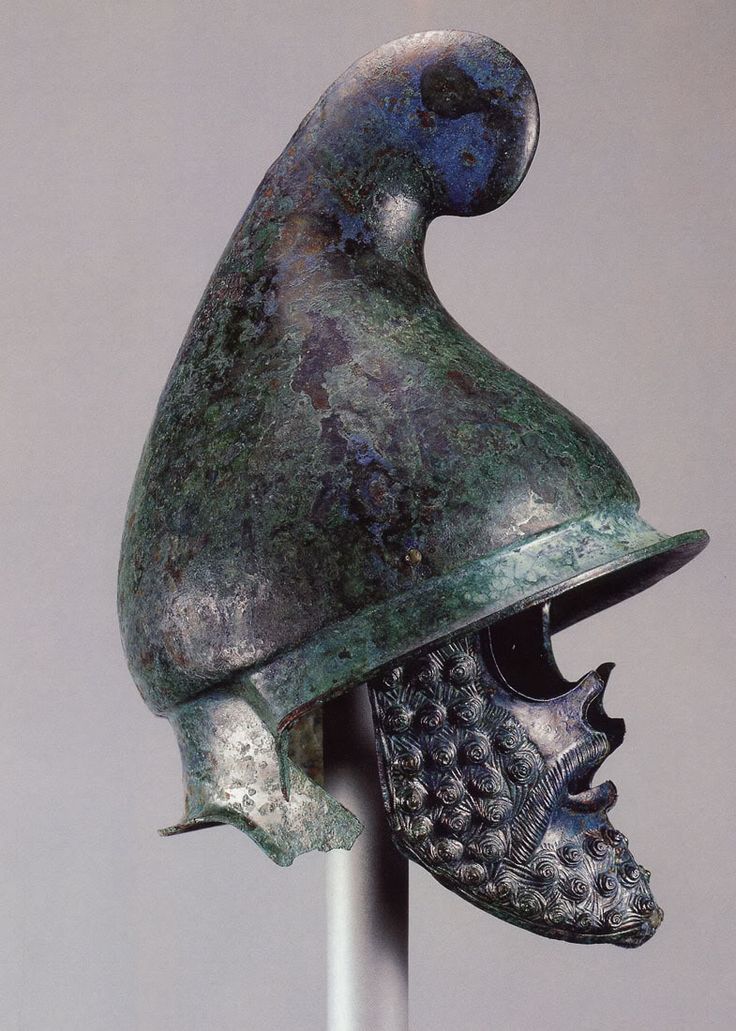
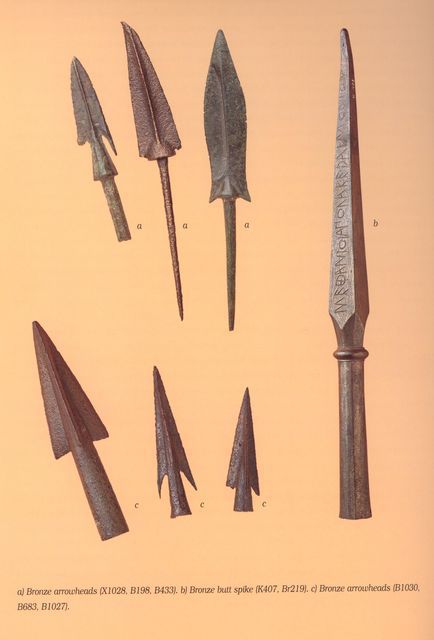
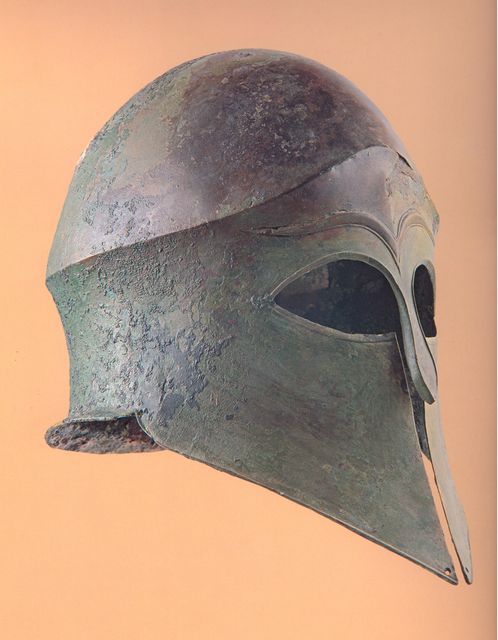
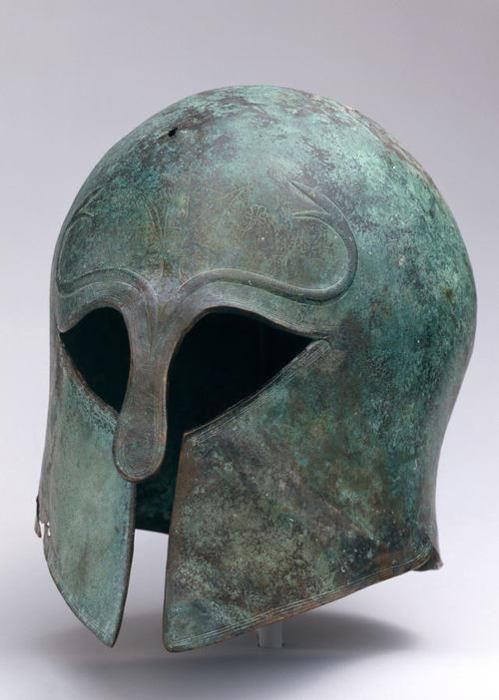
.jpg)
.jpg)
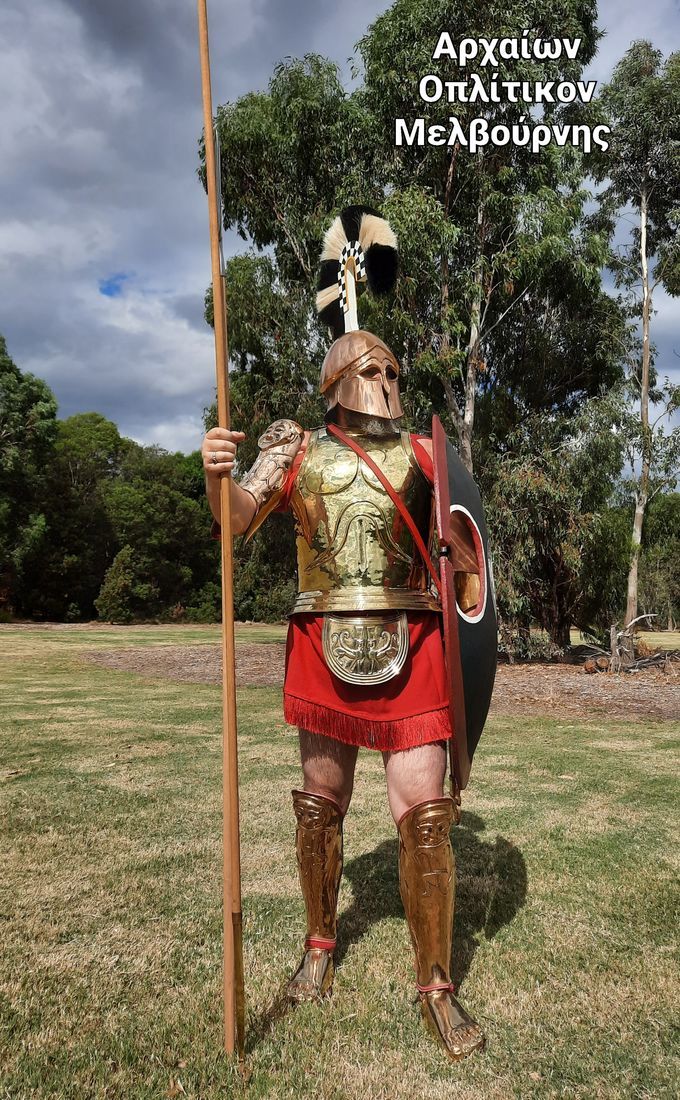
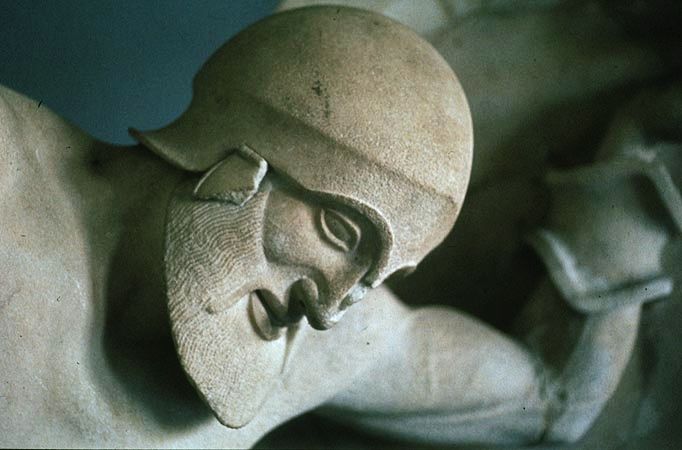
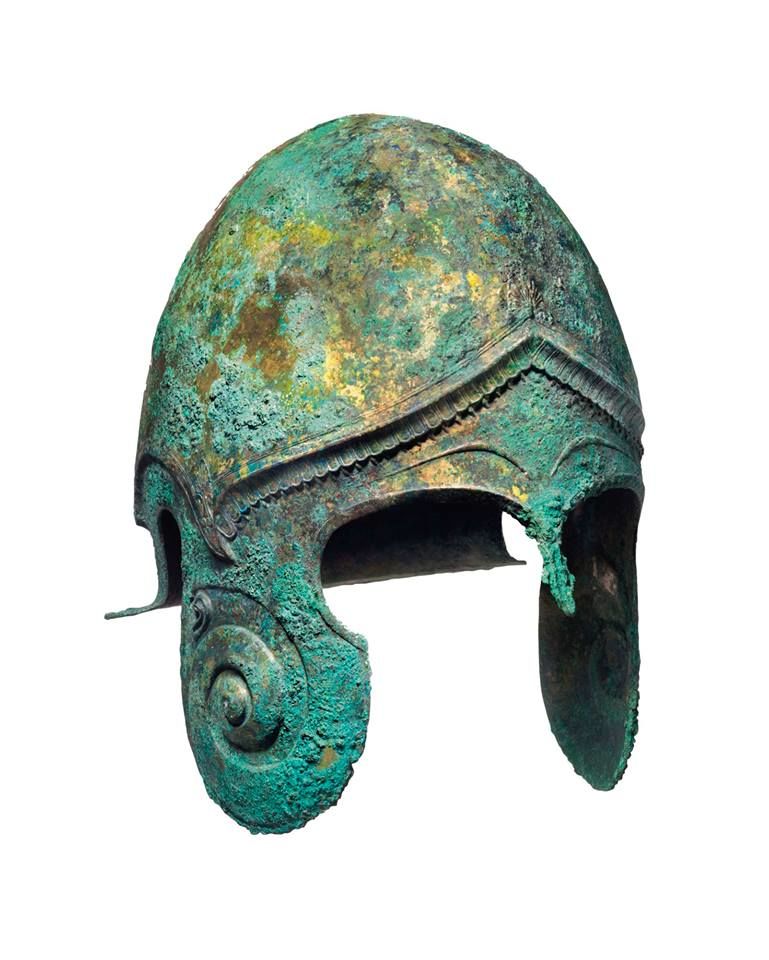
THE MYTH OF THE HEAVILY BURDENED HOPLITE
How much weight did these Warriors carry ? Archaeological finds let us give a pretty good estimate. A hoplite was heavily burdened , carrying one or two spears, a round shield, bronze helmet, and some kind of sword, dagger or cleaver. So where does the idea that hoplites wore 30 kilos of equipment come from ? Back in 2010, Peter Krentz laid out the sad story.
"Most scholars writing in English today estimate the weight of a hoplite's equipment as 70 pounds (33 kilograms) or more, a figure that goes back to Delbruck, who took the figure 72 pounds from W. Rustow and H. Kochly's Geschichte des griechischen Kriegswesens von der altesten Zeit bis auf Pyrrhos (1852). These are German pounds, each equal to 500 grams or 0.5 kilograms, as is clear from places where Rustow and Kochly give weights in both pounds and kilograms. Their original estimate, therefore, was actually about 36 kilograms (79 avoirdupois pounds). Even this lofty figure has been exaggerated - in 1994 Richard A. Gabriel and Donald W. Boose gave the weight of a panoply ( a full set of Hoplite equipment) as 85-90 pounds (39-41 kilograms). But, as most scholars writing in English today favour 70 avoirdupois pounds, which Victor Davis Hanson describes as "an incredible burden to endure for the ancient infantryman, who himself probably weighed no more than some 150 pounds," Rustow and Kochly's figures do not deserve this veneration. They did not weigh museum pieces or attempt to reconstruct the equipment. As a result, a reviewer, Theodor Bergk, dismissed their figure as "purely hypothetical attempts, " while Hans Droysen justified his decision to ignore them by calling them "arbitrary estimates". After all the archaeological discoveries of the past century and a half, especially in the German excavations at Olympia, we can do better today"
In short, this number persisted because it was the first one on the table, and because archaeologists refused to systematically measure and weigh finds until the 1990's (and when they did, they mostly did so in Greek and German, while people becoming interested in Hoplites only read English). Krentz estimates the weight of Hoplite equipment as follows:
* Helmet 1.2 kg {Extant Late Corinthian Helmets }
* Body Armour 3.6 - 6.8 kg { Extant Bronze Cuirasses and modern linen armour }
* Greaves (pair) 1.3 kg { Extant bronze greaves }
* Shield 3.2 -6.8 kg { Reconstructions based on two extant shields from Italy ; for example , the poplar wood shield covered in 0.5mm bronze sheet in the Museuo Gregoriano would have weighed 6.2 kg / 13.5 lbs new ]
* Spear 1.5 kg { Reconstructions based on extant spearheads and buttspikes }
* Sword, Scabbard, and Baldric 1.2 kg { Parallels with Roman gladii, weight of one damaged original }
* Clothing 1 kg { Linen or wool Reconstruction }
* TOTAL (Rounded) 13 - 21 kg.
All of his figures are consistent with the weight of kit from other cultures. While modern infantry have to carry more than their body weight over the mountains of Afghanistan or the steppes of upper Mesopotamia, a Greek Hoplite carried about as mush weight into battle.
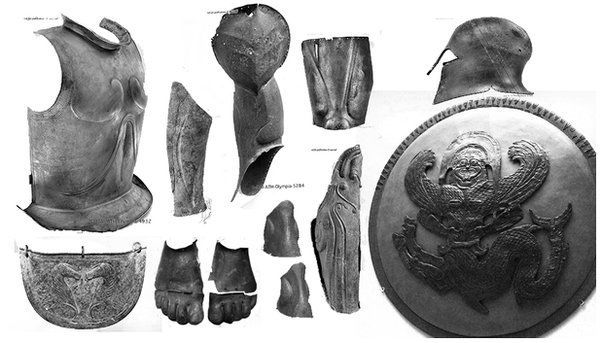
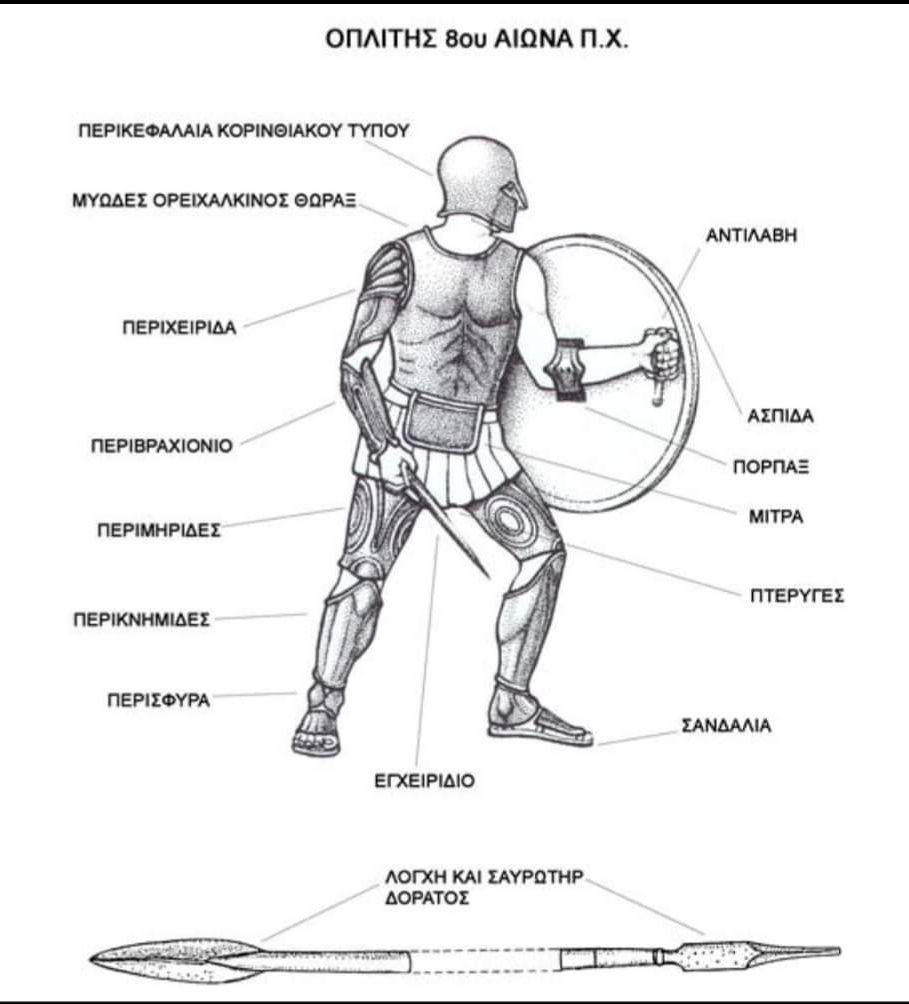
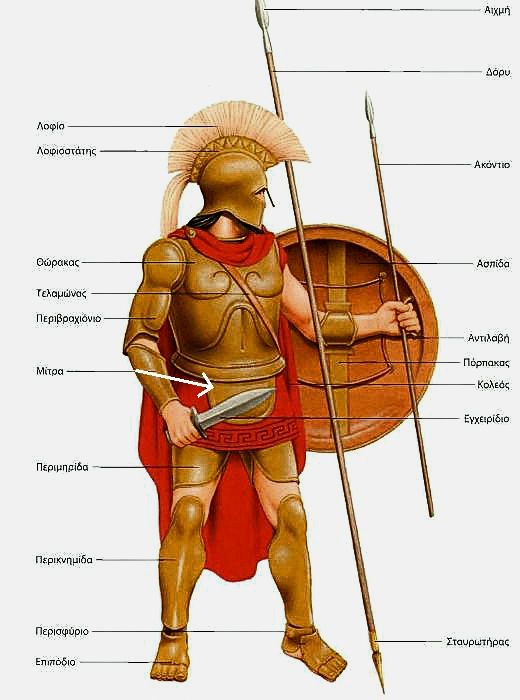
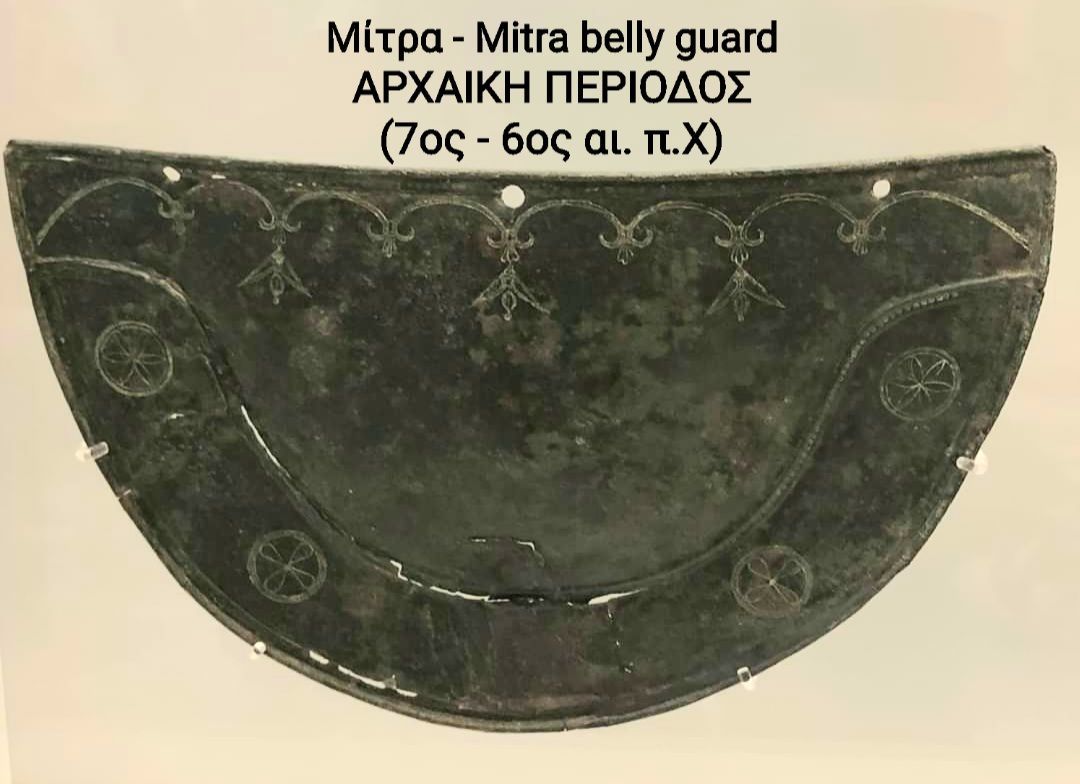
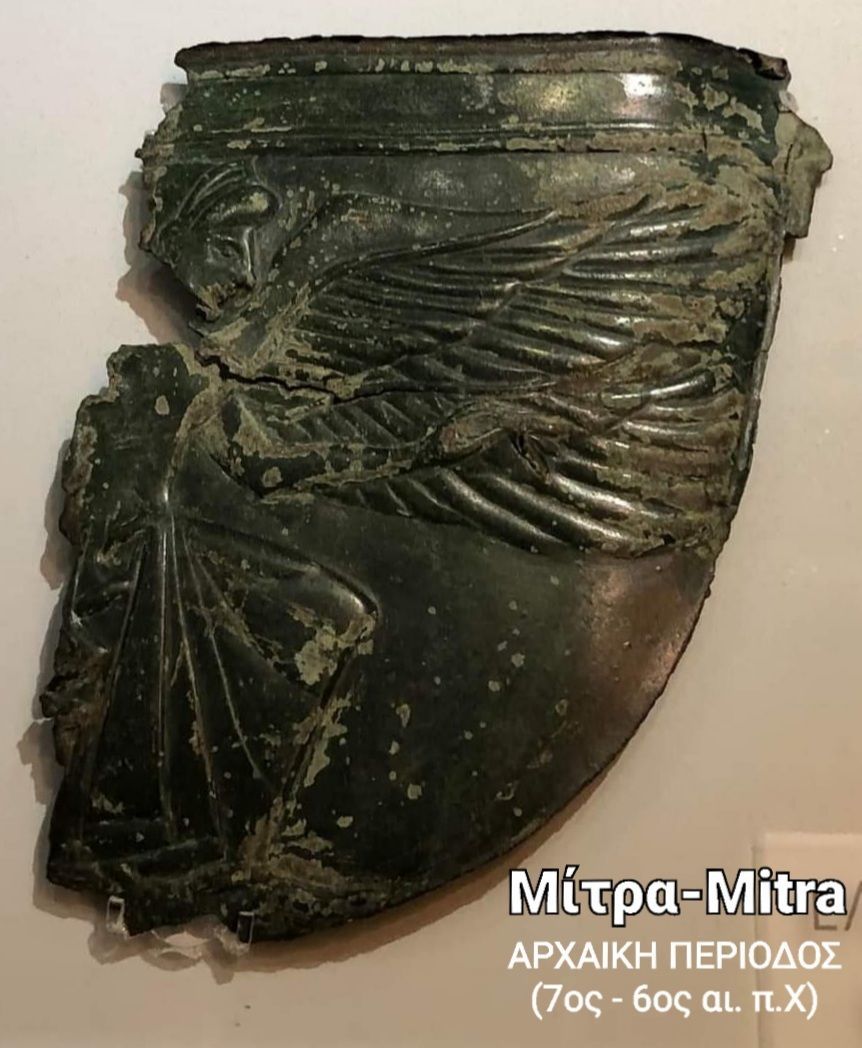
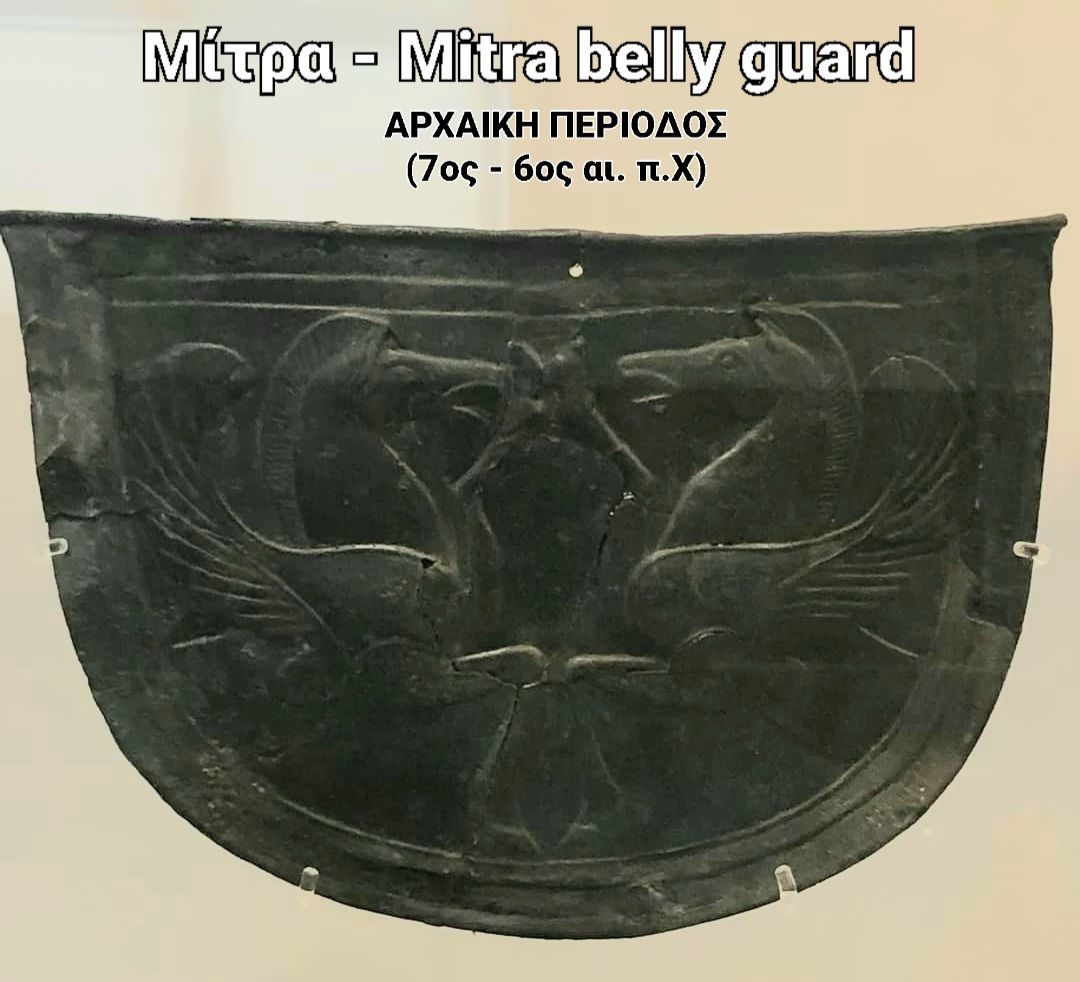
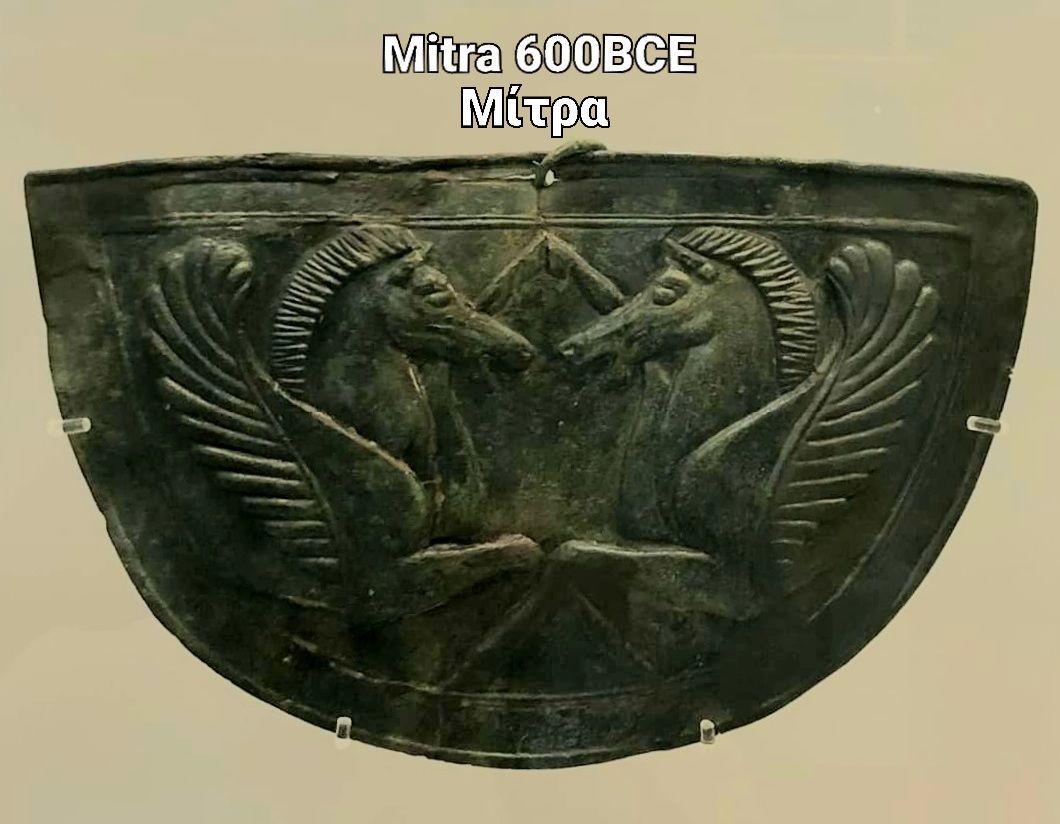
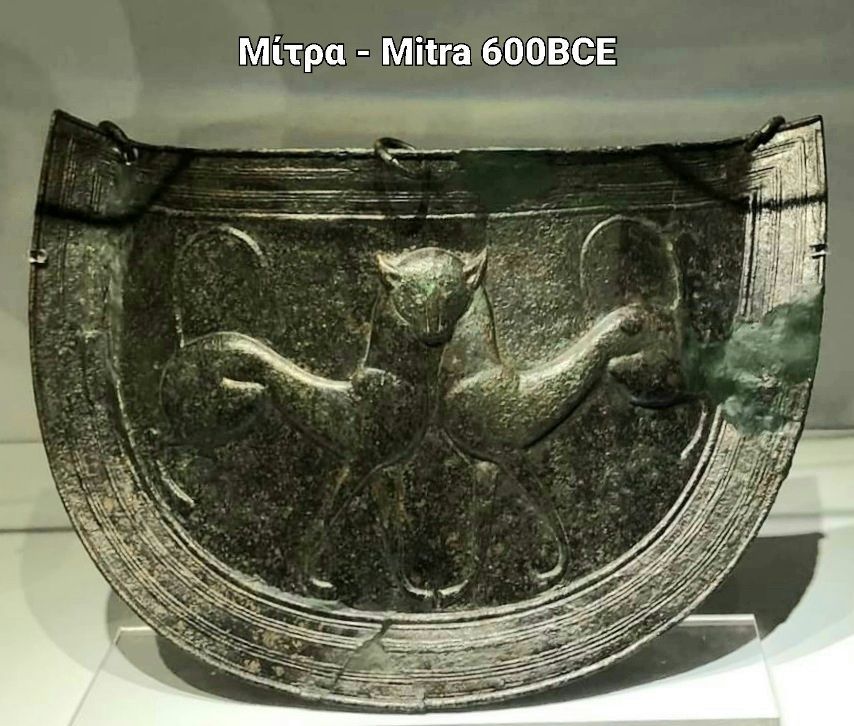
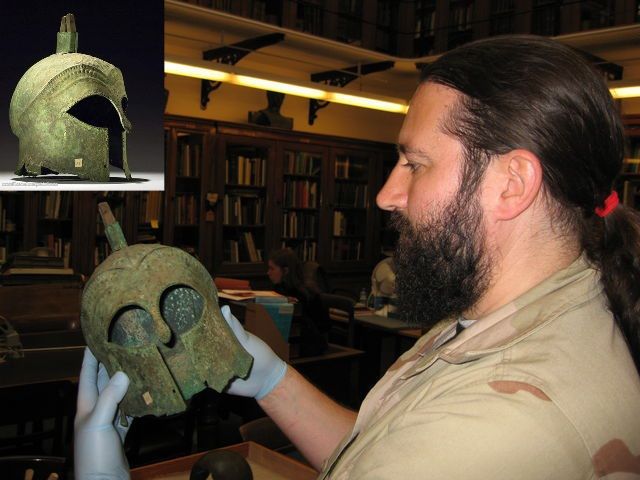
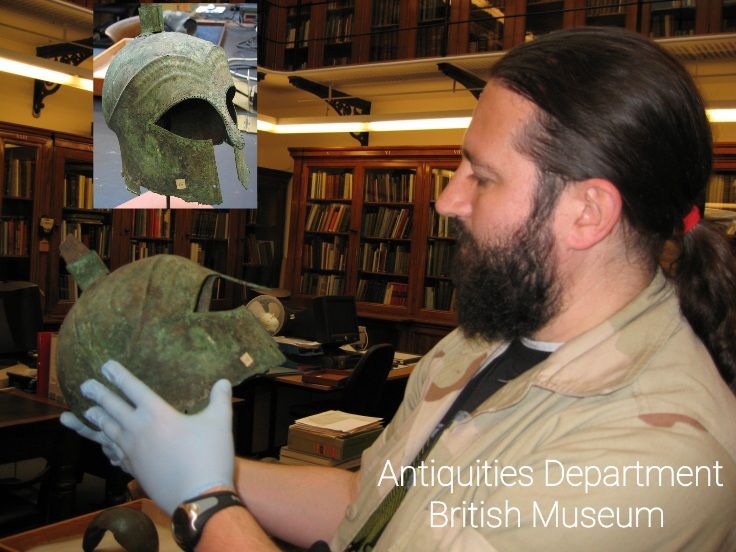
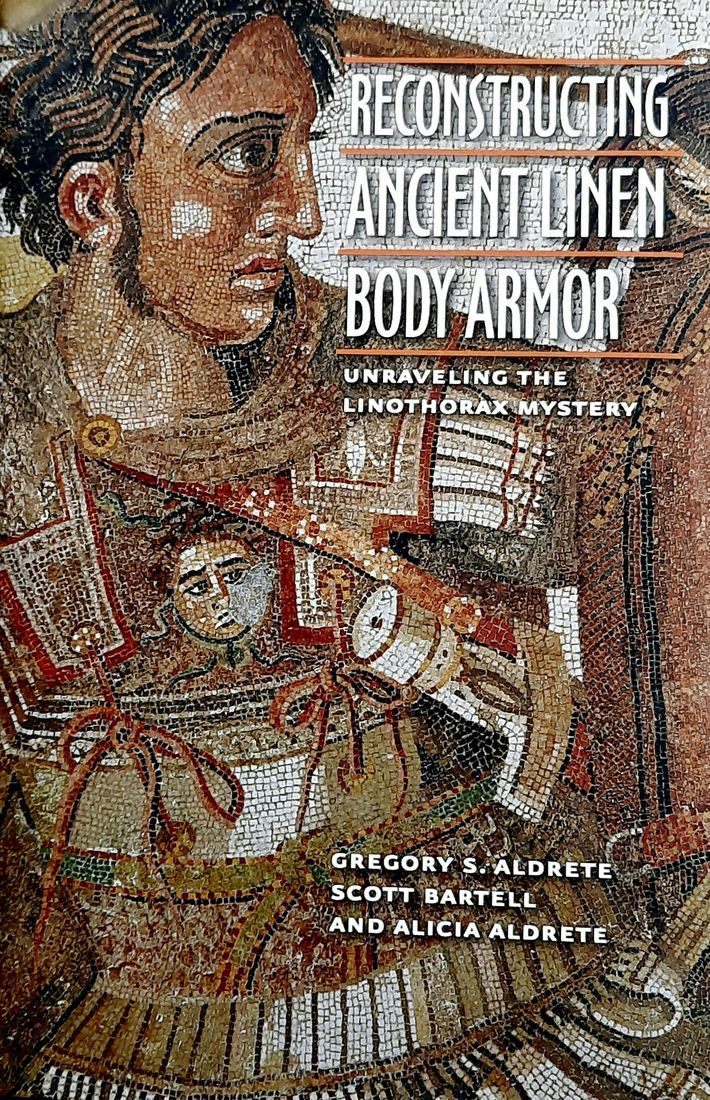
Body Armour of Glued Linen ?
The origin of the idea of glued Linen Armour.
Many people believe that the Ancient Greeks used among other things, armour that was made of layers of Linen cloth glued together. But there is no Ancient text linking Linen Armour and Glue. No other culture made Armour this way. So where does this idea come from?
Most people interested in the Ancient World have heard that Ancient Greek Warriors wore Armour of layers of Linen cloth glued together. In 2013, a group of researchers in the United States (Aldrete et al.) showed that there was no known Archaeological or written evidence for this. When Peter Connolly promoted the theory in the 1970's, there was no published fragment of glued Linen Armour, no Ancient text linking Linen Armour and Glue, and no other culture which made Armour that way. So where did the theory come from? To answer that question, we need to trace a crooked path which began in the days of Classical Scholarship. Around 1595, the famous Classicists Jusius Lipsius and Isaac Casubon were collecting references to Linen Armour in Ancient Greek and Roman texts. They did not have photo libraries or textile Archaeology, so they turned to a Medieval text to understand the Ancient writers. In Casaubons' commentary to Suetonius & Lipsius book on Roman Armies, they cited an East Roman Chronicler named Akominatos. Akominatos describes the Armour of Conrad of Montfereat, an adventurer from Piedmont who died in 1192. Lacombe did not name Akominatos, or say that the method he describes was only recorded in the Medieval text. Akominatos never claims that the method he describes was Ancient, but Lacombe still gave an accurate summary. The third essential step was when Lacombe's book was translated into English by Charles Boutell, and had to re-translate the French translation and he made a fateful choice in describing the Cuirass:
They were formed of several strips or layers of woven flax, sometimes as many as eighteen which were glued together after they had undergone a long maceration in a composition of wine and salt.
"Glued together" or "Stuck together" are both reasonable translations of French, but in the original Greek text there is no hint of sticky substance other than sour wine. But now English readers had a reason to associate Linen Armour with Glue, but not to connect it to the original Medieval source. After the translation of Lacombe's book appeared in 1869, books in English such as the seventh (1875) edition of the Encyclopedia Britannica began to say that Ancient Linen Armour was glued together. These later writers often said that Greek & Roman Linen Armour was made this way, where as Lacombe had focused on Assyrian & Egyptian Armour. Novelist and Amateur Classicist L.Sprague de Camp, describes Dionysius Tyrant of Syracuse's Engineer wearing such a Cuirass around 400BCE.
Any Eldery tailor could have told Casubon & Lipsius how to make Linen Armour by Quilting many layers of raw cloth together, Quilted cloth Armour was also made and Lipsius cited this Medieval Greek text rather than the Medieval French & Latin texts or a chat with one of their neighbours. Ever since 1595, a few learned Classicists have cited this text, but does not mention glue. The next step was when Scholars started to cite the same text to explain other references to Linen Armour, such as Herodotus' statement that Assyrians in Xerxes army wore Linen Cuirasses (Herodotus 7.63)
One of these was French Scholar Paul Lacombe who published a book on Arms and Armour in 1868. The key Passage goes as follows when translated in English (Lacombe 1868 p.48) : The Assyrians were distinguished by their helmets of woven interlaced bronze and by their Cuirass of Linen. It is difficult to form a precise image of these Helmets of woven bronze: Perhaps they were simply formed of interlaced metal strips. As for the Cuirass of Linen, Herodotus informs us that they were Armour of the Egyptians, Herodotus just says that Pharaoh Amasis dedicated a Linen Cuirass at Delphi. They were composed of many folds of Linen, up to eighteen, applied & stuck (collees) to one another after having undergone a long soak in (unsalted wine). They resisted, so it appears (a ce quil parait), a blow with the edge, but not a good thrust [ Pausanias 1.21.7]
Despite this, these Cuirasses found favour amongst the nations of Antiquity. Greeks themselves adopted them, and wore them much later, at the same time as the Thorax. He and Peter Connolly were just repeating a theory which appeared in earlier books that seemed Scholarly. They had no way of knowing that glue came from bad English translation of a French summary of a Medieval Chronicle that describes Medieval Armour, not Ancient Armour. Since Peter Connolly in the 1970's, some researchers argue that glued Linen looks like the smooth white Armour in Attic Red Figure Vase Paintings. Researchers up to 1875 do not cite art from the Aegean to support this theory. The first Researcher I can find who says that a particular Ancient painting or sculpture shows Linen Armour is Prussian Scholar Max Jahns in 1880, and it is not clear to me that Jahns means the Armour with the Yoke over the shoulders and a skirt of flaps. It is disturbing to Learn that such a famous Theory was never based on an Ancient text or an Ancient Artefact, just a third hand summary of a Medieval Chronicle, sometimes an argument which cites no evidence is more convincing than an argument which cites weak evidence. People who want to believe, challenge critics to prove them wrong, even though logically it is the believers responsibility to support their claims.
Sean Manning Contributor - Ancient World Magazine 15/09/2021
"Hypaspist" Macedonian Shield c.277-240/39 B.C. 65cm diameter, inscribed "King Antigonus Gonatas" excavated from Vegora near Florina, Thessaloniki Museum Greece
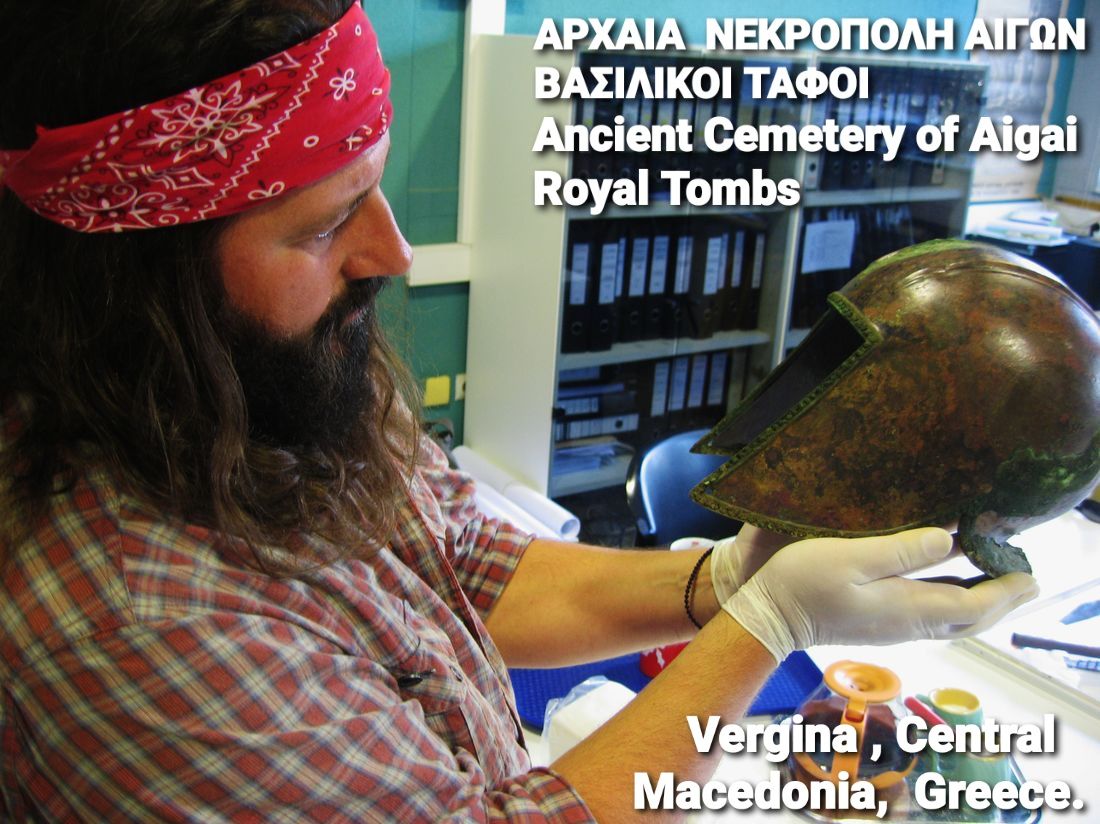
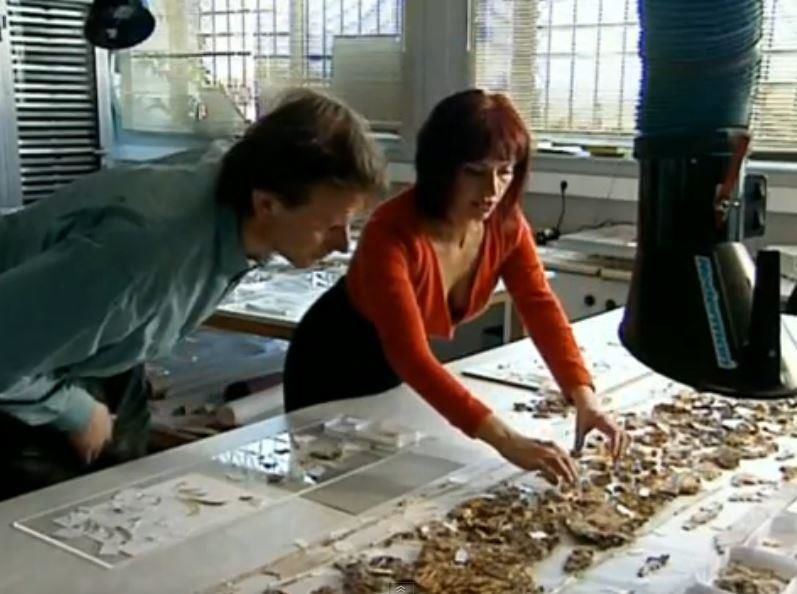
Angeliki Kottaridi
Director at Hellenic Ministry of Culture
Former Director of Museum of the Royal Tombs of AIGAI.
Edw mia endiaferousa fwtografia pou mou esteile o AqanasioV Porporh apo ena ergasthrio peiramatikhV arcaiologiaV me qema , ta arcaia opla pou kaname sthV AigeV.
Here's an interesting photo sent by Athanasios Porporis from an Experimental Archaeology Lab on, 'The Ancient weapons we made,' at Aegae.
Museum of the Royal Tombs of Aigai (Vergina) Greece.